Usborne Science Puzzle Adventures: Doctor Genius and the Mad Scientists - The Time Warp Virus
Only the second book in the series, and they’ve already run out of premises that have anything to do with actual science.
Usborne Science Puzzle Adventures #2 and Doctor Genius and the Mad Scientists #2 are both also #Final in each of those sub-series, and perhaps we begin to understand why when we read the title “The Time Warp Virus.” It’s a surprisingly apt title for an Internet review of a twenty-year-old book; less so much for a book which is meant to involve puzzles based on real science, neither time warps nor computer viruses being so. In a sense, I see their problem; the book is nonetheless too grounded in modernity to be an Usborne Puzzle Adventure, since they mostly preferred ghosts and mad science and other borderline-fantasy ideas. Regardless, I still think Clive Gifford et al. - all of whom return from their work on The Flask of Doom - simply lost their grip on what this series was meant to be about all too quickly. With the added flaw of the book dating really badly…
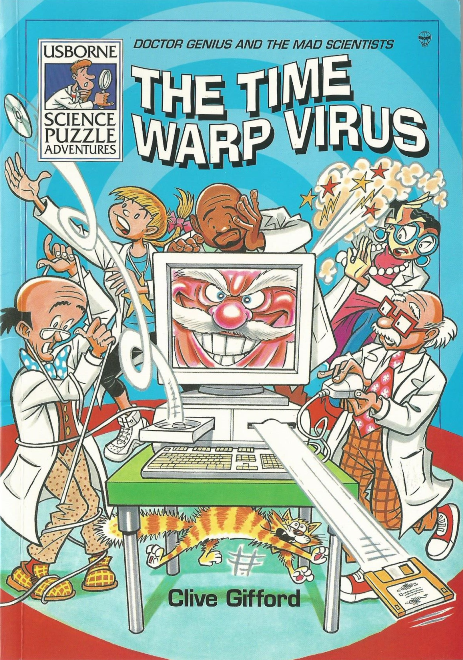
As the cover depicts, we have been blasted through a terrifying time warp back to the 90s when adults didn’t understand computers. Just slap this in the funnies page of the newspapers, minus the red-faced geriatric whose balloon-like head has inflated to occupy the entire monitor, and you’d be onto a winning satire on the difficulties your grandpa had with those new-fangled thingamajigs back in the day. For all his wits, Doctor Genius doesn’t even know how to use a mouse, holding it aloft and apparently attempting to manipulate the roller ball with his fingers, whilst clicking with his little finger stuck out like he’s the lady of the manor drinking a cup of tea. Suki Beaker and Rosie Bloom are doing their best to look active and engaged with the scene, despite the perspective revealing that they’re actually standing quite a few metres away, Suki retreating from a minor electrical storm whilst Rosie’s horrifying skeleton hand reaches out to grab a CD that’s being fired in the opposite direction. Elton Bolt gazes upon the whole scene with an air of naked disappointment. Frank Quark is just a mess. The cat is hardly even in the book.
Yeah, I should probably mention that this cover is actually a very poor representative of the actual plot of the book. Surprised?
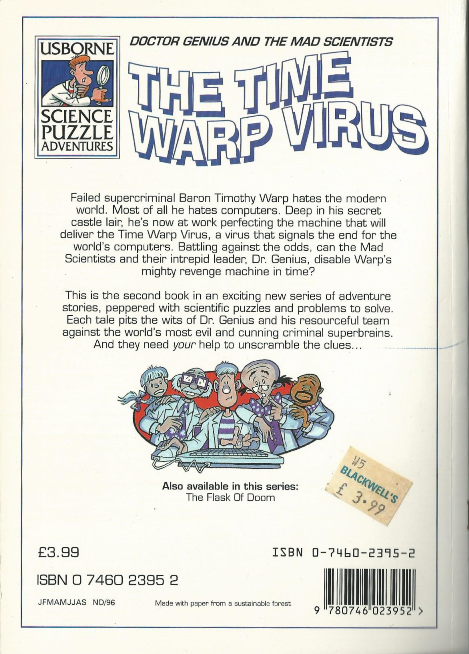
Oh look, Suki Beaker is arbitrarily missing from a group shot on the cover again. What a surprise.
Anyway, the back cover also does a pretty poor job of telling us what the book is actually about. Can you tell from this synopsis what the eponymous Time Warp Virus actually does? Nope, which is a shame, as like the Flask of Doom from the last book it’s actually not a bad idea, just overhyped by the outlandish title. At least we have a suitably colourful villain in the conveniently-named Baron Timothy Warp, who despite being either a former or attempted supercriminal (it’s not clear which) and naming his computer-annihilating virus after himself has yet to be apprehended by the authorities, even though he lives in an actual castle, so once again it’s going to be up to the Mad Scientists to bring him in rather than calling the police to report a crime. On the plus side, spooky castles are a classic Usborne Puzzle Adventures setting so it’s hard to see how we can go wrong there, even if they are mega-generic and, you know, not really suited to either the theme of science or computers.
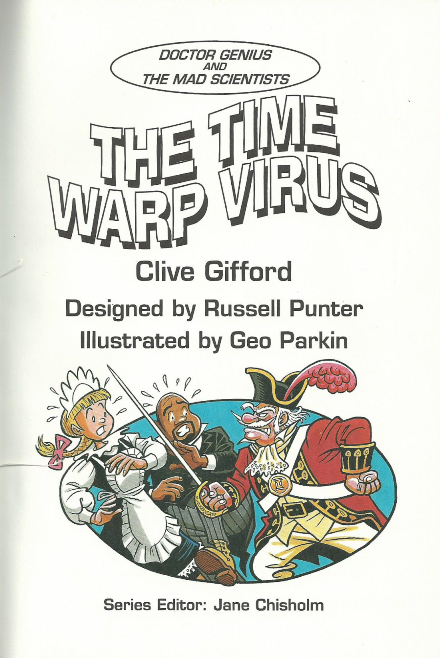
In further evidence of this book’s time-warping credentials, we see here that it anticipated the cosplay phenomenon.
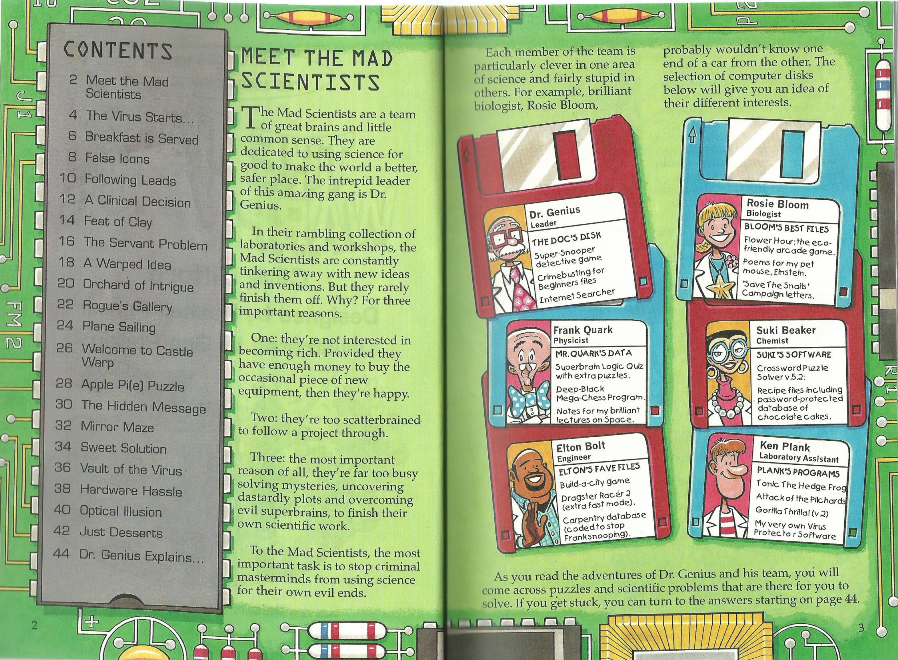
You know the drill by now, I presume. This tag yourself meme depicts the Mad Scientists, a seemingly-random group of people of whom only one has any visible qualifications, who are slightly better at defeating supercriminal plots than they are at actual science, not that that’s saying much. Also, that example of Rosie Bloom’s particular blind spot suddenly strikes me as fairly arbitrary and, like much else, only indirectly related to scientific investigation. Couldn’t she not know one end of a telescope from the other? Or a particle accelerator?
Those disks though… I’m just kind of inwardly groaning here. Where do you even start. I don’t know what the scan quality on these is going to be like, but Dr. Genius’s files basically confirm that he is just an armchair detective with no actual interest in science. Do we even know what his doctorate is in? Frank is a total try-hard as usual even while only signing his name as “Mr. Quark,” so there we have it, just in case you thought any of these others had doctorates but just weren’t saying as much. What has this man been doing with his life, I mean just look at him. He’s in his forties, at best, and yet he’s calling himself a scientist despite not even having a doctorate and depending on literal children to read this book and solve puzzles for him. Elton obviously isn’t even a scientist; carpentry, for crying out loud. Rosie is so depressed at being dropped from the denouement of The Flask of Doom that she’s started writing poems for her pet mouse because she knows he’s the only one who’ll listen. The author couldn’t come up with anything chemistry-related for Suki’s interests that wasn’t painfully domestic, and yet it’s password-protected? Is she planning on publishing her recipes, is she actually trying to get a real job that isn’t being a fake scientist? Ken Plank is just a loser who downloaded some obvious malware disguised as virus protection from the Internet to protect him while he’s pirating knock-off video game hacks.
I don’t have any particular prejudice towards this book, and yet reading this page I just feel such contempt for these people. Irrational? Or all too rational? Either way, it’s a good start!
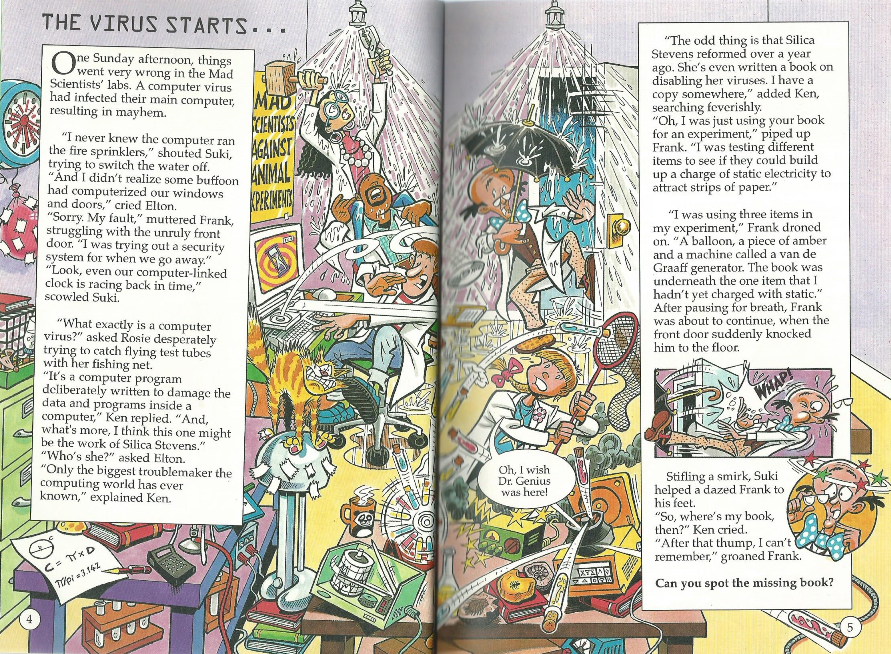
Okay, while at first glance this just looks like a rehash of the front cover’s ol’ “hackers can turn your home computer into a BOMB” theme, it turns out it’s actually another example of the Mad Scientists’ idiocy: Not only do they have lousy computer security, but they have linked absolutely everything in their laboratory to the computer, including the doors. Not the discs being ejected from the computer at rocket speed, though, that’s just magical computer virus witchcraft. What does the computer virus actually do? Whatever random thing would make this page look really funny, which is fair play, I guess. Maybe that’s Silica Stevens’s specialty, cartoon viruses that can do just about anything, though how Ken knows this virus is her work I don’t know. What I do know is that Ken knows far more about computers than he does about science. Maybe he should just go join the Mad Computer Technicians instead. Get himself a proper role.
Also, since I said the cat was hardly in the book, just look at this page and tell me where the text mentions it. It gets a nod on the next page, but this is the one and only time it’s illustrated. Clive Gifford and Geo Parkin just wanted to see a cat get electrocuted; ironic, given that “Mad Scientists Against Animal Experiments” poster… Rosie Bloom ought to look into this horrific animal abuse, maybe that could be the Mad Scientists’ next case. Though really, this is all just Frank’s fault - as is the puzzle on this page, which is only barely connected to the actual plot: Basically he nicked off with Ken’s computer security book for an experiment, except he then admits that he wasn’t using the book at all. That man is just the worst. No wonder Suki is so entertained when he’s smacked to the floor. That’s his fault too, by the way, as he’s the one who hooked up the computer to the doors, so he has nobody but himself to blame.
Anyway, how about that puzzle. Well, there are three elements in Frank’s experiment: A balloon, a piece of amber, and a van de Graaff generator, and two of them are charged with static. You have to identify all three of them - and no cheating, as not just they but several other props have been stacked on top of books, goodness knows why - and then identify which two are charged with static electricity. It’s actually a well-designed puzzle, to its credit, as you don’t need to know anything about van de Graaff generators or static electricity to solve it. Just locate the balloon and the amber, and from there, infer what static electricity does and what the van de Graaf generator might have in common with them.
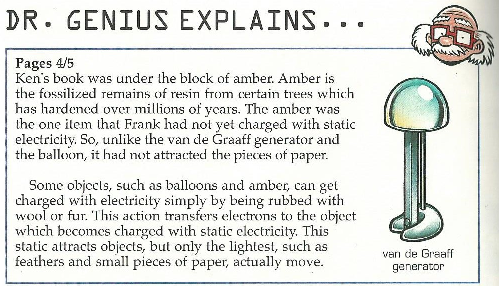
Dr. Genius doesn’t actually really explain what static electricity is here, just what it does. But hey, at least it’s a science puzzle.
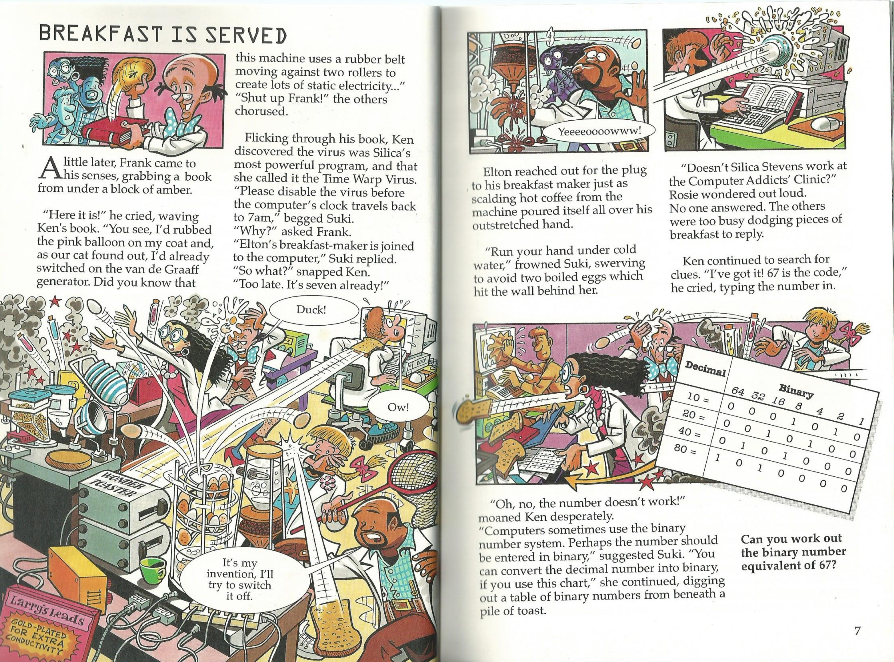
A fundamental difference between this and earlier Usborne Puzzle Adventures is that USPA has a tendency to just flat-out tell you the answer to the puzzle on the next page. It even goes most of the way to explaining it. Tell me why we need an answer section, again? Anyway, everyone tells Frank to shut up, so this is a good page.
Well, no, not really, it’s not a good page. The book has this… really weird habit of continually referring to elements and effects of the virus as if we’re familiar with them, when we never have. For instance, right here, Suki talks about the computer’s clock travelling back to 7am as if this was a thing we already knew was happening, but it’s not established at all; the previous page mentioned a computer-controlled clock, but this appears to be different. Nor does anyone actually connect the fact that the virus is called the Time Warp Virus to the clocks going backwards, we’re left to assume for ourselves that this is the virus’s main feature. And then Ken discovers that 67 is the code - great! The code to what? Nobody’s introduced any need for a code or what it would do or how it relates to the virus. It’s like there’s a paragraph missing somewhere that ties all these things up, but it’s just dropped in favour of more breakfast invention slapstick that Wallace & Gromit had been doing better for years.
Also, the Time Warp Virus wasn’t invented by Baron Timothy Warp, so it being basically named after him is a complete coincidence. Which isn’t necessarily a problem, but stacked up with everything else I’m already starting to get the feeling that, like the previous title, the plot of this book needed a second pass. Or an actual editor. Looking up series editor Jane Chisholm, it seems like pretty much everything she worked on was non-fiction. …And quite a lot of it computer-related. Coincidence?
Oh, and last but by no means least… this is a maths puzzle, like, flat-out. Just call it Usborne Educational Puzzle Adventures and be done with it!
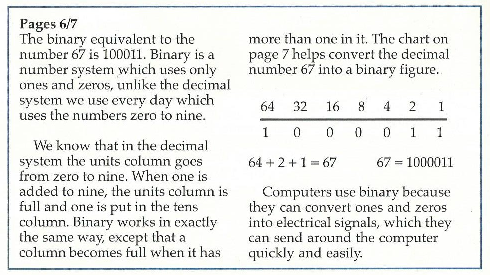
A maths puzzle, maybe a computer puzzle, but certainly not a science puzzle. This whole sub-series needed a second pass.
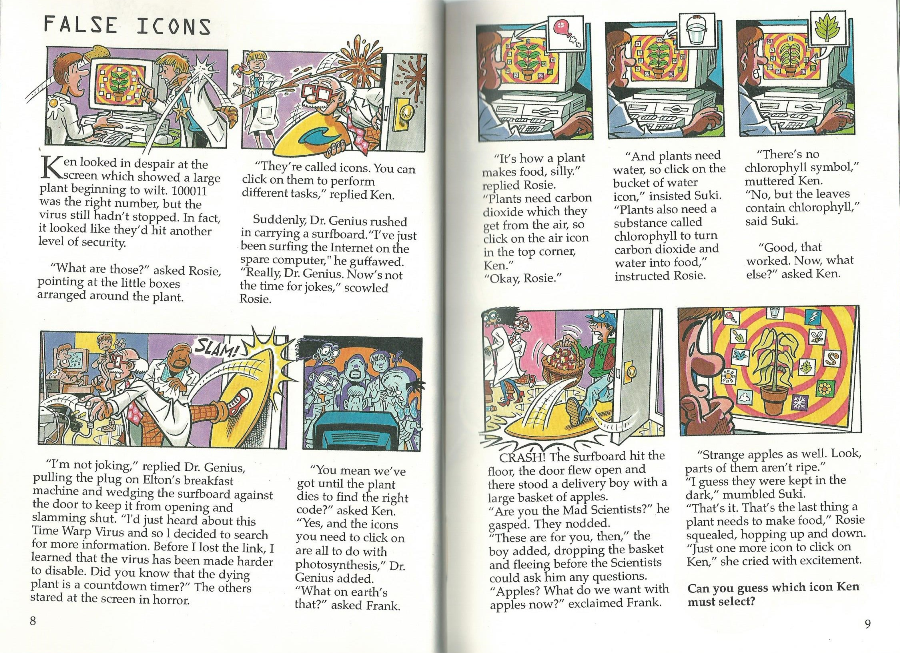
More than half the pictures on this double-page are just of people looking at a computer screen. Exciting stuff. Now, please learn about some of the most basic elements of computer operation while we remove this virus the only way fiction writers of the 90s knew how, by solving a puzzle the virus writer inserted to let you defeat their efforts with no consequences by solving some general knowledge test or a whimsical logic puzzle. Watch out, ransomware scum, I’ve read a book.
Meanwhile Dr. Genius conveniently learnt everything about the Time Warp Virus off-screen on the Internet, completely invalidating everything Ken’s done in the plot so far. And Suki appears in the group shot which the one on the back cover is based on, in which she does not appear. Somebody at Usborne really didn’t like her. I don’t think it was Clive Gifford, though, as on this page she appears to know just as much about photosynthesis as the biologist member of the team, who is robbed by mysterious apples of her chance to shine. Get it, shine? It’s a pun on the answer to the puzzle? Which they pretty much give to you, and it’s the easiest one anyway?

No complaints about the answer, just about the puzzle’s presentation. I don’t get why some of the panels had different background colours, or why there was no indication of which icons had already been clicked. Don’t think of it as “poor design,” think of them as red herrings!
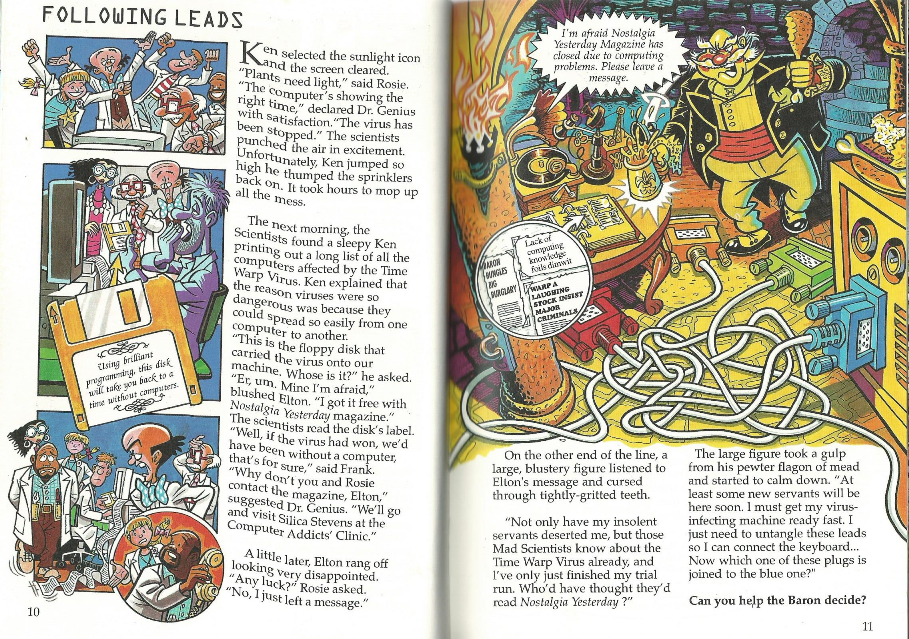
Ken is the butt of the book’s jokes this page, getting everyone soaked by the sprinklers and then being reduced to this horrifying computer zombie with an actual five o’ clock shadow, in an amazing enlargement by Geo Parkin upon the text’s simple “sleepy”. Ken also appears to be a leet hacker as he has a long list of all the computers in the world that have been affected by the virus… for some reason. Why does he need this, again? Also, everything is Elton’s fault rather than Frank’s, for a change. A floppy disk through the mail, really, Elton (I actually typed “Frank” there out of habit). But who could resist that cryptic yet nattily-designed message! Yeah, no wonder Dr. Genius no longer trusts Elton to even make a telephone call unsupervised.
Well, it took a quarter of the book, but the villain finally appeared, and he’s the best character in the book already. Overlook the fact that his master plan was to send his own telephone number with the virus, and that he keeps a big scrapbook of his personal failures (all the newspapers interview major criminals on petty gossip), and look how much more Geo Parkin was enjoying this second page than the rest of the story. Flaming torch, gramophone, a pewter flagon of mead! This is great! There’s even a classic trace-the-paths puzzle, for which I’ll forgive the fact that it’s once again computer-themed rather than being related to science. I’m not even questioning why we’re supposed to help the Baron here, he’s the reason we’re reading this, let’s be honest.
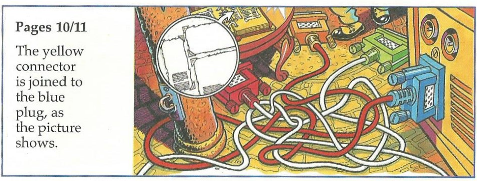
Ordinarily, in this sort of puzzle, you’d expect the other two cables to be joined to each other. Well, it’s a minor point.
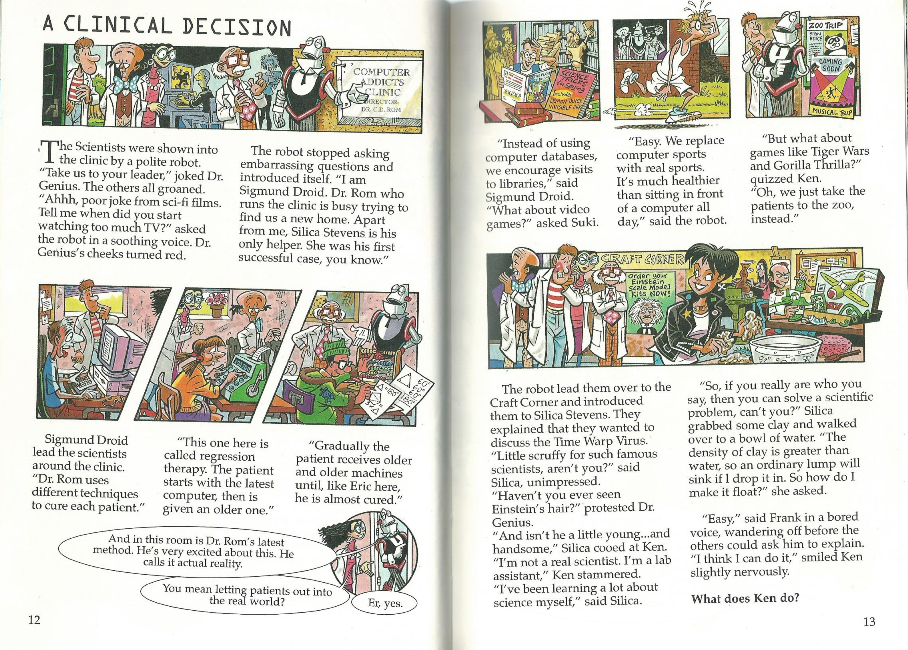
At the Computer Addicts’ Clinic, Dr. Genius is humiliated by a robot. Deservedly. I don’t even know what reference he was trying to make there, everyone knows “Take us to your leader” is the thing the aliens say to the humans. If a human says it to a robot, that’s not even a reference at all, it’s just an embarrassment. Also, this robot apparently has human-level intelligence, so nice job putting a factual error in your educational book. Or is it okay if it’s a computer science error rather than an actual science error?
Clive Gifford racks up what he clearly thinks is some pretty biting satire on those crazy kids who spend all their time on their computer by slowly weaning them on a radical alternative therapy called “actual reality.” Just jump twenty years into the future and say that, why don’t you. I bet he wrote the book on a computer, too. Hilariously, Gifford and Parkin’s idea of “actual reality” involves reading a copy of The Flask of Doom. But you all read that on a computer in the last instalment, didn’t you? You’re part of the problem!
But at last, we are introduced to Silica Stevens, who turns out to be a cool hacker girl wearing a leather jacket. This book couldn’t be more 90s if it tried. Just watch her know more about science than the actual Mad Scientists, though. Hell, put her on the team! She can replace Frank, he’s not doing anything. Like literally, he doesn’t even bother solving the problem, he just runs off so he doesn’t have to prove anything. Get out!
…Despite the last few pages all cramming in subtle details in the images which are blatantly hinting towards later puzzles, I’m not sure how you’re meant to solve this one unless you already know it. Unfortunately I saw the answer while leafing through the book to check something a while back, so I’ve no idea how easy or hard this would have been if I’d actually had to think about it. You want to alter its density, I guess…?
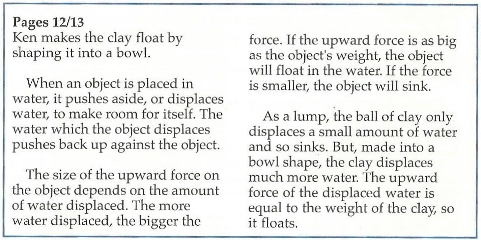
Well, yeah, you do want to alter its density, but one of the most verbose answers in the book, for a puzzle which strictly speaking has no direct importance to the plot, doesn’t actually mention density anymore. It kind of switches to a different principle, that of displacement, even if changing the volume of the clay object does, in fact, reduce its density. The more you know! Apparently this is a classic science experiment, but funnily enough, I don’t remember ever encountering it myself. Then again, I’ve read this book, so I suppose I have no excuses.
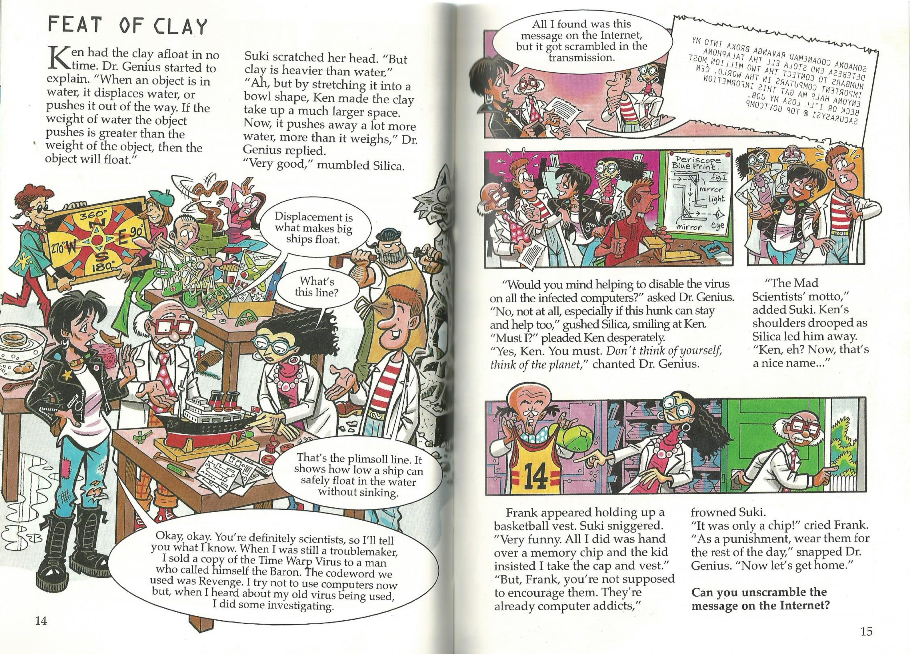
What is it with Ken and actually knowing things and being worthwhile in this book. The foundations of my world are trembling here. Though I have to say, I like how somebody finally asked for proof that the main characters are actually scientists. After all, anyone can put on a lab coat, right?
Uh-oh, though, looks like somebody has a bit of a soft spot for Ken! Whose reactions I kind of can’t figure out; he was looking pretty bashful himself the previous page, but the moment Silica herself expresses an interest, he backpedals like crazy. And then everyone laughs at him. Poor Ken, he has to go and spend some quality time with the cool hacker girl who has a massive crush on him and isn’t afraid to say it, who’d want to be in his shoes? Don’t worry, Ken, you’re doing it for the planet! Remember the Mad Scientists’ motto which they never mentioned before and blatantly made up just now!
Meanwhile Frank ruins some kid’s rehabilitation and gets given a basketball shirt. This awful man just taints everything he touches and Dr. Genius rightly loses his cool with him… while Suki laughs some more. Well, at least one person’s enjoying themselves. Abruptly a puzzle.
The puzzle is… well, I am aware that you at home cannot actually read it, but trust me, you are not missing anything. It’s mirror text with frills. Like they could at least have typed it backwards rather than literally mirroring the whole thing, that just makes it obvious. There’s this whole vowel-swap thing that it feels like they threw in there after the fact as they realised the puzzle was too easy, but no, it was still too easy.
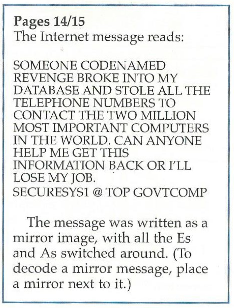
Are you serious? You’re talking to an Usborne Puzzle Adventures veteran here, you think I don’t know how mirror text works? Back in my day you had to use a mirror just to read the hints, blah-blah-blah, yackity schmackity. Meanwhile, top government computer security experts put out calls for help to random people on the Internet. Are we… like given that you just told us that Baron Warp had previously gone by the codeword “Revenge,” are you seriously telling me this man who supposedly knows absolutely nothing about computers managed to hack into a top government database? Heavens above, is there anyone useful in this tragic world.
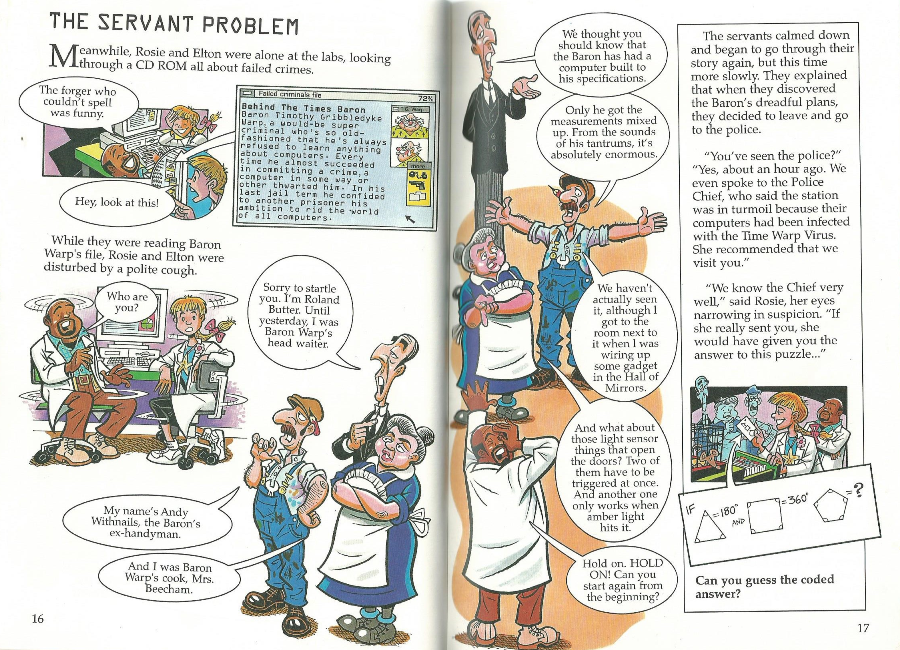
…Well, Rosie and Elton sure aren’t being useful. They’ve completely abandoned actually investigating the Time Warp Virus and are just chortling over a file about bumbling criminal morons of the sort even they can defeat. They come across vital information about Baron Warp entirely by coincidence. And, in much the same way as they couldn’t be bothered to do any work, Clive Gifford also couldn’t be bothered to think of any ways in which Baron Warp was actually foiled by computers.
Speaking of not doing any work, suddenly a bunch of ex-servants show up and start babbling a bunch of clues and foreshadowing. So the Baron mixed up his measurements and had an enormous computer built? I guess he’s behind the times with the metric system as well as computers. To my complete astonishment, we learn that somebody actually went to the police… and what do you know, the police were useless. If they can’t do anything with their computers, doesn’t that kind of free them up to do some actual police work - oh yeah, that would entail somebody in this story actually doing something useful for a change.
So, hold on. Like this guy is some kind of ex-criminal - who the servants nonetheless freely chose to work for before this whole computer business came up, by the way - and what scared them off was when he built a giant computer. Are these yokels even more technophobic than him?
Anyway, and now we get another puzzle that… well, yeah, it’s maths-based again. Not even halfway through the book, and that’s two of them already. And less than half the puzzles we’ve encountered so far were science puzzles. Are we sure Clive Gifford knew he was meant to be writing Usborne Science Puzzle Adventures here?
So. All the angles in a triangle add up to a hundred and eighty degrees; all the angles in a square, three hundred and sixty. So all the angles in a pentagram…?
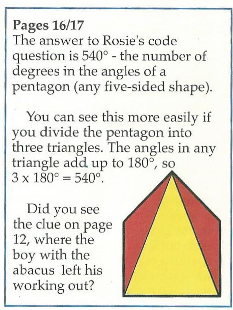
Told you they’d started dropping hints like crazy. And some of them are even science-based, too…
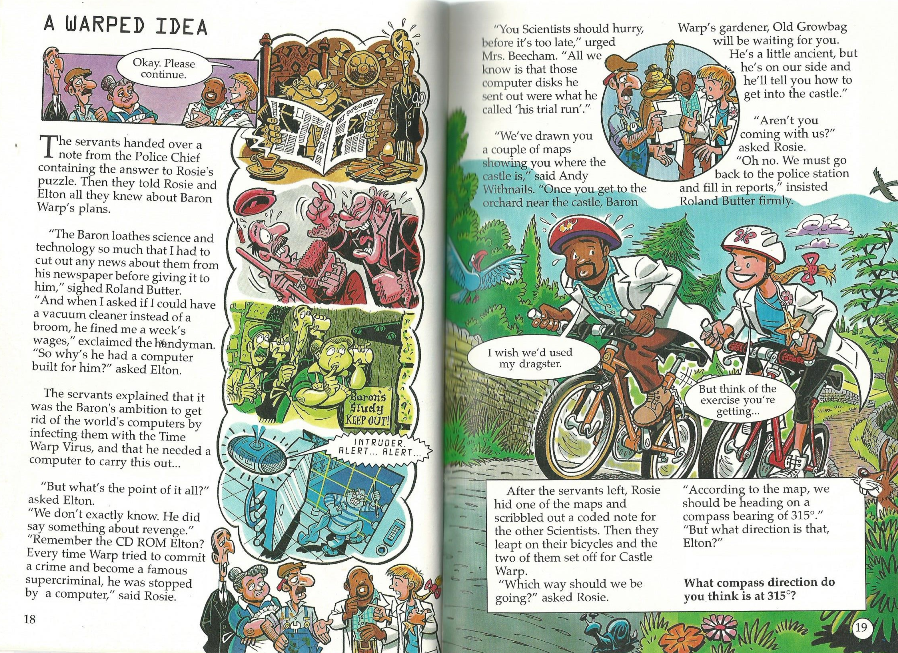
For some reason I didn’t pick up at first on the fact that the servants don’t actually have to solve the puzzle, they literally just got given the answer by someone else. Why did it even have to be a puzzle, then? Why not a codeword, or just a piece of paper ripped in half? Er, anyway, apparently the servants know for a fact that Baron Timothy Warp is behind the Time Warp Virus and literally told them that he was doing this for revenge, but the police still can’t be bothered to send somebody to deal with the source of the Time Warp Virus because they’re too busy dealing with the Time Warp Virus… and getting the witnesses to fill in paperwork. I kind of think this world deserves everything it gets.
On the plus side, we’re getting closer to the interesting bit, which is that this book has a castle. Apparently this world has no atlases, though, so the servants had to sketch up some maps of their own to direct Rosie and Elton to a notable landmark. You know what, I’ll take it. Given how incompetent the police are, Baron Warp could’ve taken down all the signposts and nobody would be able to stop him.
Time is of the essence, so Rosie and Elton don’t bother to contact the other two-thirds of their team… but Rosie does insist on taking their bikes out. We’re in a hurry, Elton! The world is depending on us! Pedal faster! Wait what the heck is that bird to the left of Elton. For crying out loud we had some perfectly decent cliff-nesting seabirds in the previous book, but no, now all we’re getting are Pokémon rejects. Now, flip back another couple of pages and tell me what direction 315° is. You did remember to bring a compass, right?
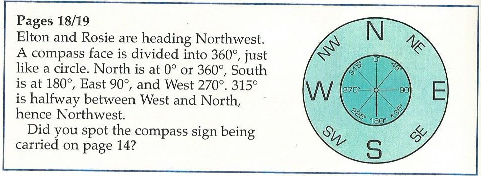
You know, if they were asking me to remember some entirely fictitious fact or spot some narratively-relevant detail, I’d be fine with it, but here it just feels like they’re giving the answers away. On completely different pages.
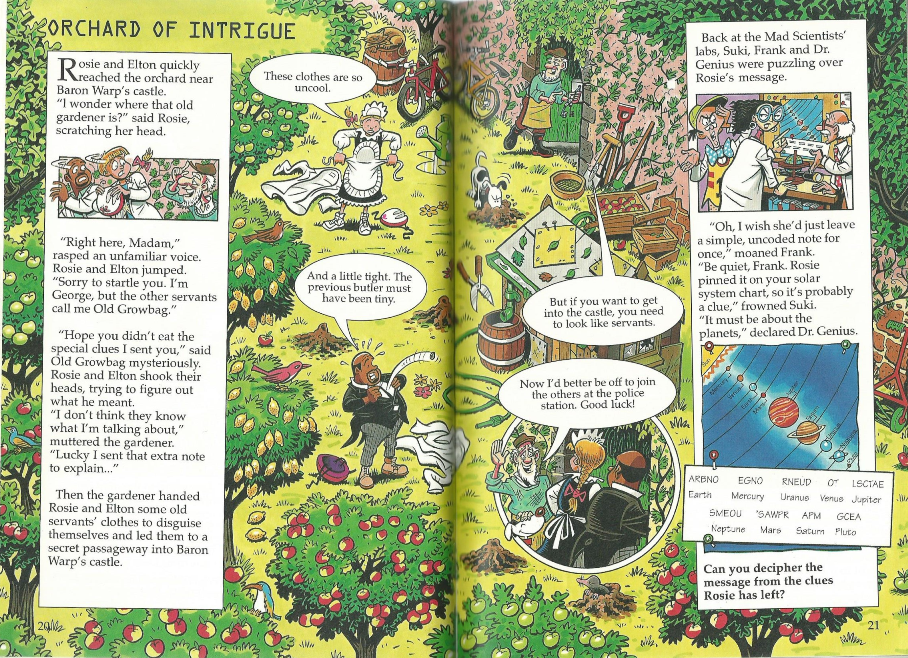
Suddenly a creepy old man jumps out of the bushes and tells Rosie to put on a maid’s outfit. Woah, I didn’t think this was that kind of story. It turns out the gardener (probably) sent that basket of apples earlier, but anticipated that the Mad Scientists would ignore his clues, so he sent along an extra note, which they have also ignored. Why is he relying on these people, again? I mean, just look at this: Elton complains, “The previous butler must have been tiny!” Elton you met the previous butler. You last saw him one page ago. (Admittedly, he was called a “head waiter,” but we haven’t seen any other butlers and his costume was identical.)
Meanwhile again, Frank has indeed been bullied by Dr. Genius into wearing the basketball shirt and cap, and is complaining as usual. Far be it from me to agree with this waste of oxygen, but in this case, when time is of the essence, the whole world is upon the brink of chaos, did Rosie really have to take the time to indicate her intentions in a coded note? …That’s not even in her subject area?
Wait, hold up a bit. Frank’s a physicist. Space is meant to be up his alley. The note is pinned to his solar system chart. …Frank’s floppy disk on the opening page contains “Notes for my brilliant lectures on Space.” And yet he’s lost when presented with a space-related puzzle! This man is a damn fraud! I just… I just hate Frank Quark so much.
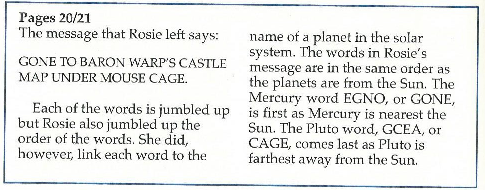
The words are anagrams and the whole sentence is out of order, and pinned to the planets for no reason? Listen, Rosie, you don’t have anything to prove. Not while you’re on a team with Frank Quark.
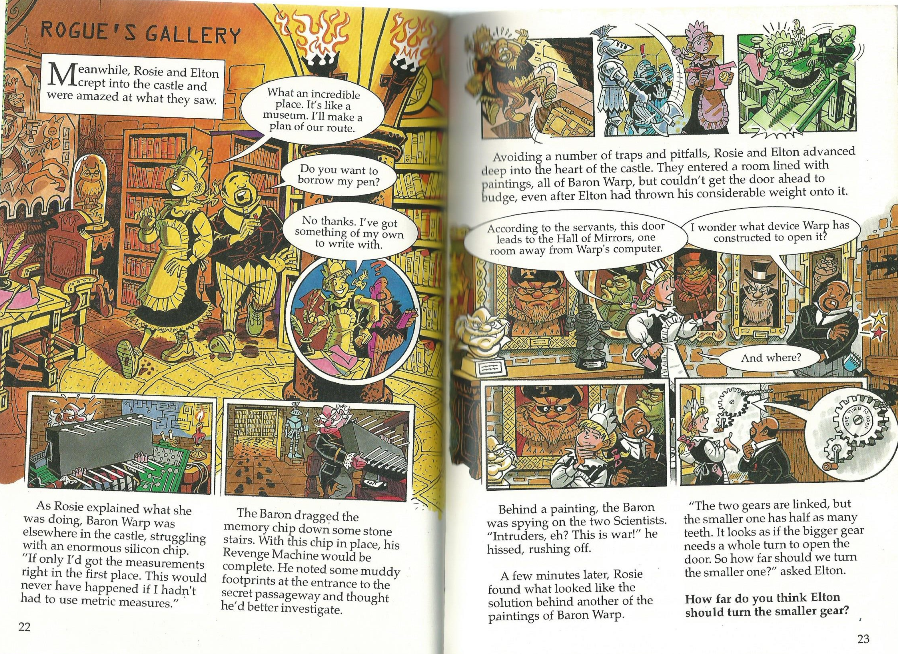
As Rosie and Elton walk through the most Usborne Puzzle Adventures castle ever, Rosie responds to a request for a pen by pulling a lemon out of her pocket. Am I living through some kind of surreal dream? Meanwhile, it’s confirmed that my quip earlier about Baron Warp mixing up imperial and metric measurements was, in fact, canon. Also, why did Rosie and Elton have to put on disguises if the Baron immediately recognised them as intruders despite their disguises? I knew that old gardener was just a creeper!
Eventually, the pair come across a puzzle which arbitrarily requires our help to solve. And… yep, it’s a maths puzzle again. But just ignore the fact that it’s unbelievably easy when they give you the fact that one turn of the small gear makes a half turn of the larger gear, and ask yourself this: Why do Rosie and Elton need to work this out in advance? Why can’t they just turn the small gear until the diagram on the large gear is oriented vertically again? Or, I don’t know, watch the door opening as they turn it? In real life, this wouldn’t even be a puzzle!

The puzzle is literally that one plus one equals two. Apparently the Mad Scientists are even worse at maths than they are at science.
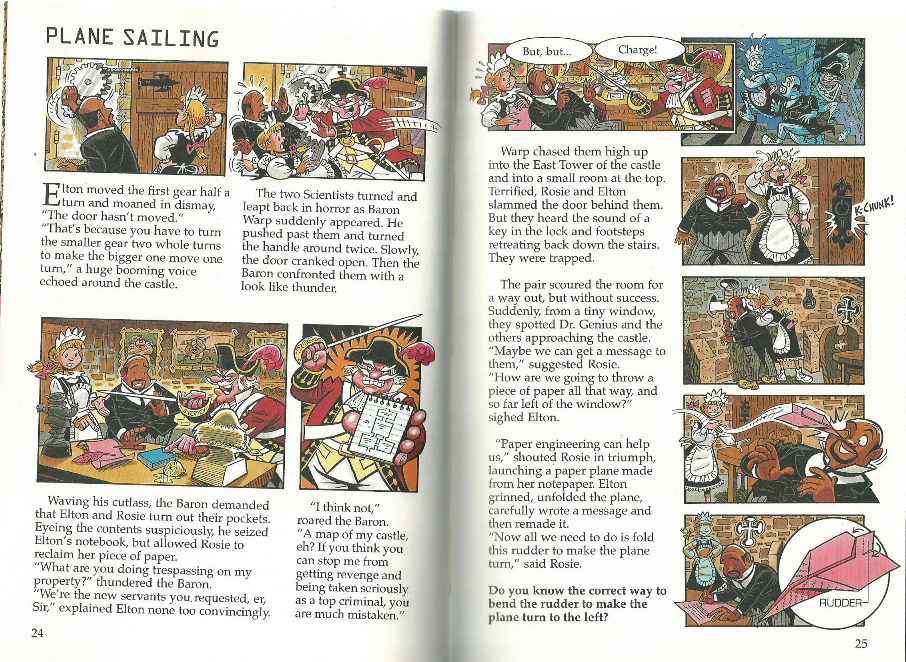
Isn’t Elton meant to be an engineer? Shouldn’t this type of unbelievably basic mechanism be pretty much his jam? I give up on trying to understand these people. Meanwhile, Baron Warp unlocks the door by turning the small gear twice, but since Elton had already turned it half a turn, this means that the large gear actually made a total of one and a quarter turns, so either the puzzle lied or you really were allowed to just turn the gear until the door opened and you could just ignore the puzzle entirely. Good job!
The fact that his new servants have drawn a map of their large and confusing new workplace proves to Baron Warp that they are actually despicable traitors, and to further his ultimate end of being taken seriously, he decides to add murder to his list of crimes and chases Rosie and Elton around with a sword. Upon being trapped and seeing a further half of the Mad Scientists arrive through a hole in the wall, Rosie comes up with an engineering solution. I know Elton refines the paper aeroplane, but did he just forget these past few pages what his specialism is meant to be? Also I feel like the two of them could just have called for help. Look, Rosie can easily fit her head and arm through that window, you’re really telling me that a scarily precise bit of paper aeroplane engineering will be better at catching Dr. Genius’s attention?
It also strikes me that this puzzle would have been more effective if the paper plane were oriented the other way in the diagram. We want it to turn left, but when facing the front of it that actually means we want it to turn right.
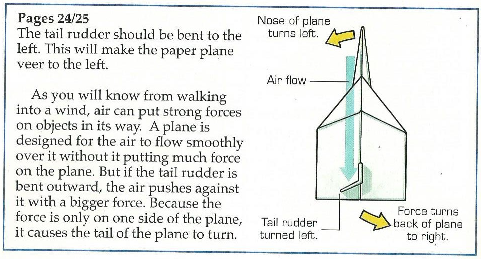
See, “left” from the perspective of this diagram is actually “right” in the orientation as shown in the puzzle. …Also I feel it’s disappointingly straightforward that to make the plane turn left you have to turn the rudder left, but I guess you can’t argue with physics.
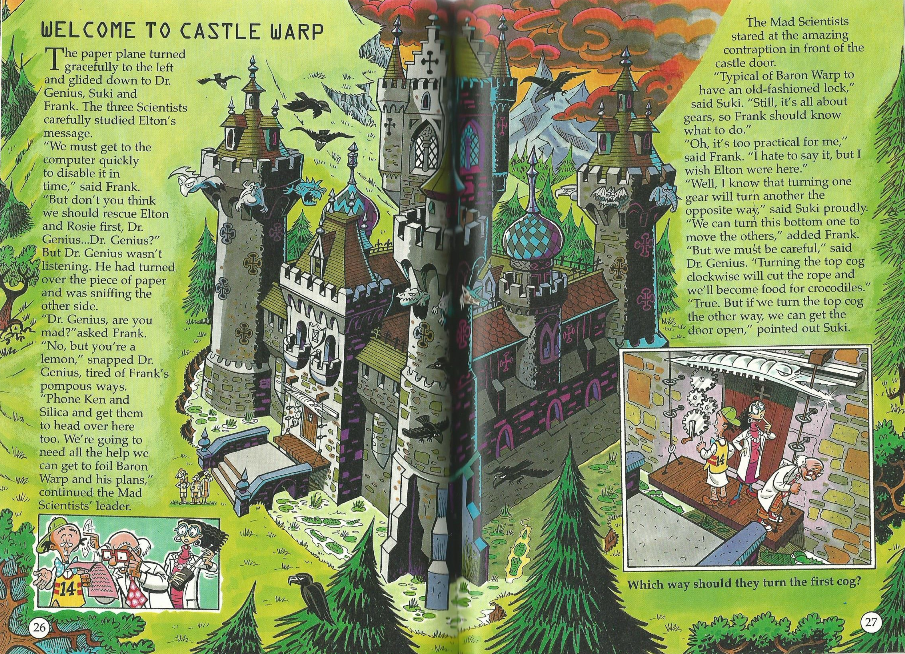
I’m revising my opinion on illustrator Geo Parkin. Give him the right material and he really comes up with the goods. This scene is gorgeous.
The text, on the other hand, is business as usual. Frank once again annoys even the other characters and then manages to be useless at his own specialism - whilst also confirming that Elton is meant to be the expert on gears, so he should’ve been on top of his game against that simplistic door lock from earlier. Based on Elton’s performance there, I wouldn’t want him to help out with this puzzle or he’d throw half the cast down to the crocodiles. But on the plus side, we’d get rid of Frank. Hmm, on the whole, it’s probably worth it.
It’s a shame that there’s a very clear visual indication of how the cog puzzle will sever the rope and plunge them into the crocodile-infested moat, but none of how exactly it’s meant to open the door. Also, once again, as in real life, just turning the handle slightly in either direction would show you which direction it moves the crocodile in without moving it enough to endanger the drawbridge, but this puzzle is more interesting so I’ll give it a free pass. Standard rules apply, though; all that really matters is whether you have an odd or an even number of gears, as each extra pair of gears cancels out.

Complicated only slightly by the psychological factor that the crocodile both does and doesn’t work like a gear. It’s actually quite an interesting design.
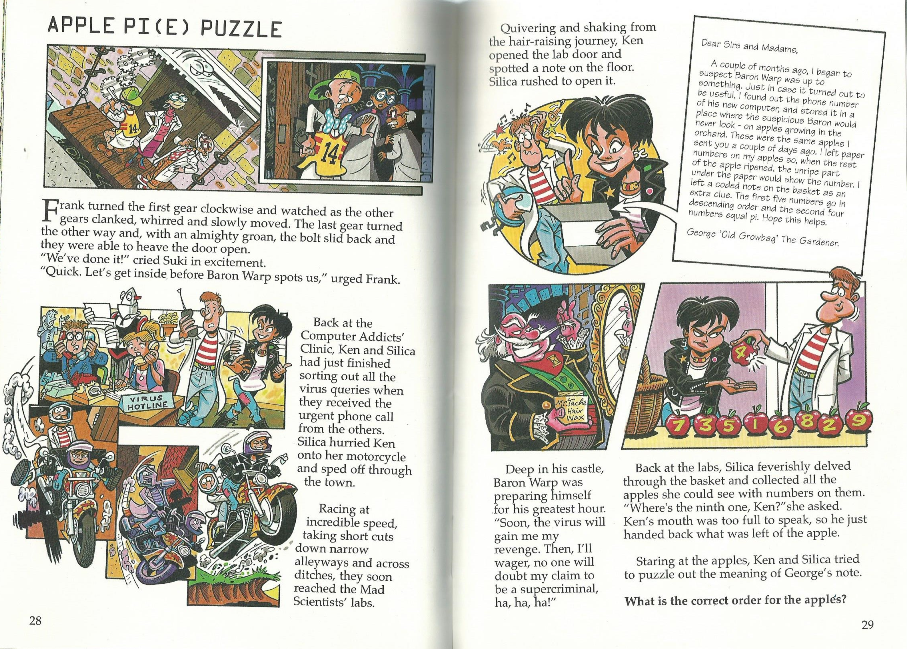
As Frank’s cap grows ever larger with each fresh page, we cut back to Ken and Silica Stevens - remember them? Silica Stevens, being a cool 90s hacker girl with a leather jacket, also owns a motorcycle with flame patterns painted on it, but as the character with the best design in the entire book - save maybe Baron Warp, who has about half a dozen different designs - she gets a free pass on clichés.
At last, we find out what that business with the apples was about. It was so Old Growbag, the creepy gardener, could record the phone number of Baron Warp’s computer - wow, that takes me back, to the days when the Internet explicitly dialled through your phone line and so you couldn’t surf the web and make a telephone call at the same time, and you couldn’t be connected for more than about fifteen minutes per day without running up a huge phone bill. This must seem insane to anyone born since the millennium. Anyway, rather than just memorising the phone number, Growbag split the numbers and pasted them onto apples and then sent them to some scientists, along with a note explaining how to deduce the phone number from the apples, even though he could just have written the phone number down and sent it in the note. Or told Rosie and Elton the phone number when they arrived at the castle, since he had to have remembered it in order to provide the correct clues.
Also old Growbag seems extremely confused about both the chronology of the story and the number of notes he sent. He claims he sent the apples several days ago, but they only arrived less than twenty-four hours ago in the story’s chronology. Also, we’ve seen no sign of the coded note supposedly left on the basket, only the note Ken and Silica are reading right now, which implicitly is the one which came with the basket of apples, except it appears to have been written several days after the apples were sent… The convoluted set-up of the apple puzzle makes slightly more sense if you assume that Growbag is getting a little bit confused in his old age.
…Also, this is another maths puzzle, isn’t it. Mitigated slightly by that seemingly extraneous but totally fabulous panel of the villain waxing his moustache. Clive Gifford can’t do puzzles, but he sure can do villains.

I was going to say that it was awfully convenient that there were no duplicate numbers in the Baron’s phone number, but then I realised it wouldn’t actually have made the puzzle any more difficult if it did.
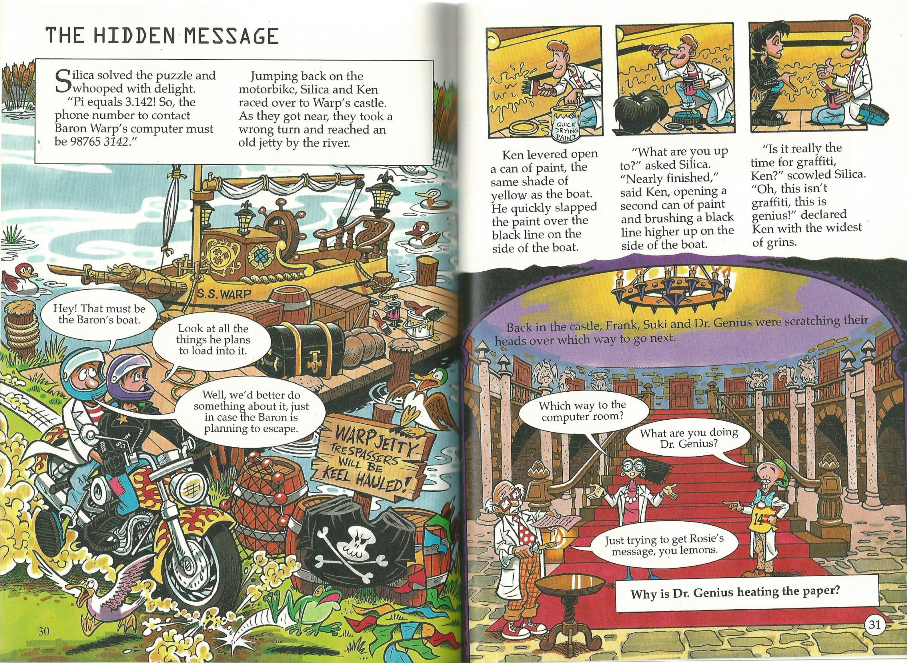
Silica narrowly avoids crushing some more interestingly-designed wildlife - the bird designs have been on-point again since that cartoon blue bird way back when Rosie and Elton set out - and quite by chance she and Ken stumble upon an apparently irrelevant tangent. I kind of wish this had been an unspoken plan and we’d only get the plimsoll line punchline later, but it’s very rare for Ken to do something actually intelligent so I guess we’ll give him his moment in the sun a bit early. Also wow, look at that boat’s figurehead, it’s something else. Still doesn’t top the figurehead of a certain ship in A Series of Unfortunate Events which is shaped like a person in a diving suit being attacked by an octopus.
Meanwhile, the rest of the gang try to find the computer room. They’ve gotta go fast!
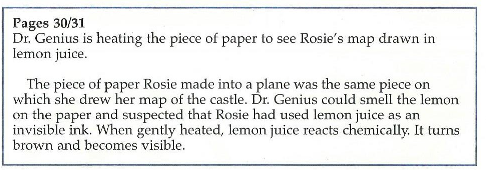
Probably the reason they had Dr. Genius rub it in by repeatedly calling Frank a lemon - not that you really need a reason - is because Rosie had no reason to write her map in invisible ink in the first place. How would she even keep track of what lines she had drawn already?
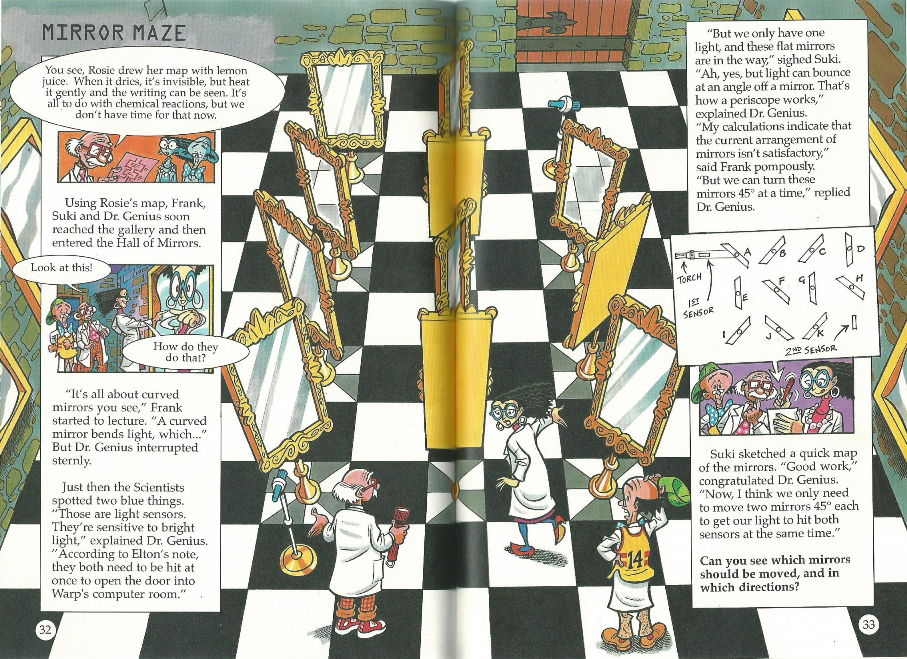
Frank and Suki stare gormlessly at their brilliant leader as he explains the lemon juice trick. It’s all to do with chemical reactions! Wait, isn’t Suki a chemist? Oh for crying out loud.
Also Frank once again starts lecturing loudly and the narrative doesn’t even bother to tell us what Dr. Genius said to him, it’s enough that he just shut him up. I like to think that Dr. Genius didn’t say anything to Frank, just gave him a swift smack ‘round the chops.
On the other hand, we do have a real science puzzle here at last! And it’s a good one, too. I always like these kinds of puzzles. I’ve no idea why they bothered with the slightly misleading blather about two light sensors when you’re given one for free at the start, but the puzzle even has the good kind of hint where you’re told just how many movements you need to make! Though you need that kind of hint. If you had free movement of the mirrors, you could brute-force any number of possible combinations. Actually, puzzles like this are really just another kind of maze, and as with many such mazes, the easiest way of solving it is actually to work from the end backwards.
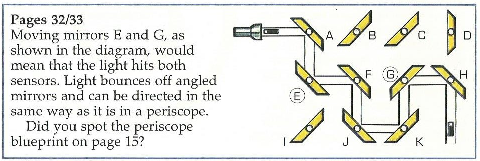
The periscope was kind of an abstract hint to relate to this, considering that periscopes are vertical and this is horizontal, even if the principle is the same when drawn on paper. Also, you point out this hint and not the pi and invisible ink hints?

Well, that’s everything all wrapped up for the Baron! Looks like, as in The Flask of Doom, there’s to be no final confrontation between the Mad Scientists and the villain, just an attempt to derail an automated plan he set off well in advance. Well, they are scientists. They don’t really do final battles. In both books the heroes did actually confront the villains at one point and lost and were captured, so stealth is clearly the better approach.
So, Dr. Genius, Suki and Frank open the door, only to immediately find… another door. Creative. They’ll need an amber light to get through that door, and if Rosie and Elton had left proper notes back at the lab then Dr. Genius could’ve brought the actual physical chunk of amber Frank was using in his experiment, but no, they need to jerry-rig something out of the wrappers to all these chocolates Suki is hauling about. I won’t judge. …I won’t judge Suki, but hark at Frank once again blathering away, to camera, while Suki and Dr. Genius do all the work. Has Frank actually done anything useful in this book? At all?
Wouldn’t you know it, there aren’t even any yellow-wrapped chocolates in this whole heap. Fortunately, there’s another way to make yellow. That’s right, Frank’s basketball shirt! …Would’ve been a clever out-of-the-box solution, but nope, it’s the chocolates.

Now this I think you did need a hint for. So of course there isn’t one. The puzzles in Usborne Science Puzzle Adventures are a fairly awkward balance of inside observation and required outside knowledge. Don’t know about primary light colours? Too bad, the world is doomed, and all because Frank Quark can’t do his job.
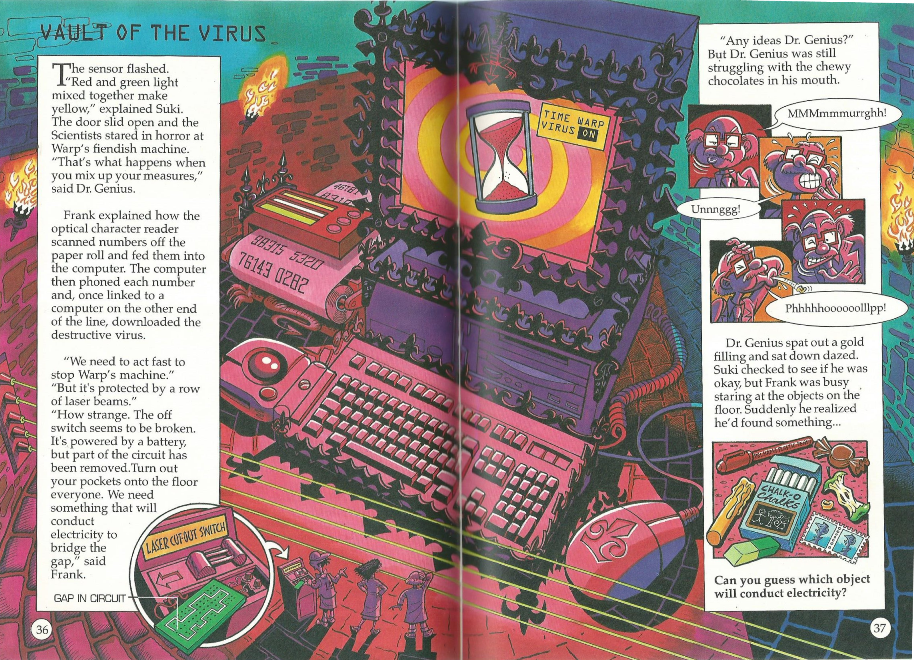
And to give the old technophobe credit, when he builds a computer, he builds a heck of a computer. Baron Warp doesn’t do anything by half-measures. Though of course, measures are precisely his problem. Are we sure that, rather than confusing imperial and metric, he didn’t mix up his decimal points and use commas instead of periods?
But oh no, the computer is protected by a row of laser beams that are clearly several feet off the floor and which we could easily crawl under! Also laser beams are just light, they don’t actually harm you, so you can walk right through them since there’s no security system they could set off that wouldn’t stop you from simply pulling the power cord out of the computer. But details. This is secondary to Dr. Genius getting so greedy for chocolates that he actually loses his fillings. Those toffees are pretty vicious, it must be said. Take caution in cold conditions.
Oh yeah, I guess I should mention that Frank Quark’s time to shine finally came. Sigh. You know he’ll never stop bragging about this. Even if what he had to do to succeed was kind of disgusting.
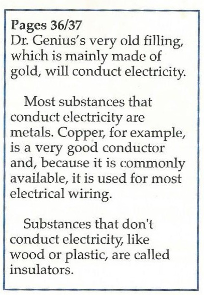
Of course, the fact is that the castle’s full of metal things and the characters are probably toting around a lot of metal stuff as well that they simply didn’t think of. But when the filling’s right there and it’s the right size and shape, you just have to grit your teeth (eh?), bite the bullet (eh eh?), and generally grin and bear it (eh eh eh… well, that’s not quite so directly tooth-related, I guess).
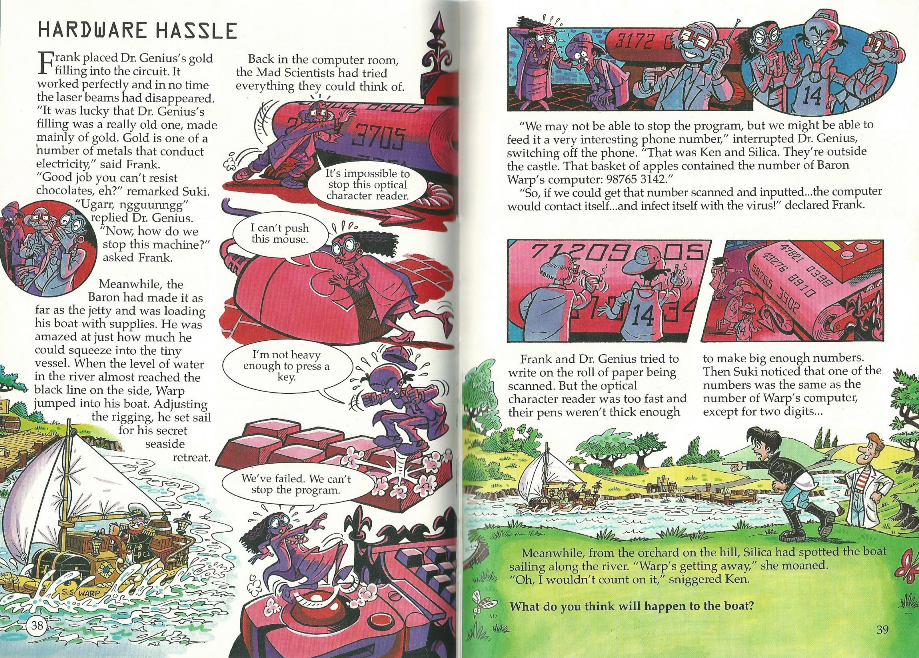
Frank slowly regurgitates the answers page after having already solved the puzzle, leaving the Baron plenty of time to merrily sail away. Apparently the computer is also built to exceptionally sturdy specifications, as the frail and weedy Mad Scientists are unable to affect it even slightly, or possess the imagination to look for a power cable. Or maybe it’s battery-powered? I’m not terribly certain that Warp Castle even has an electricity supply…
Fortunately for all, Dr. Genius pulls out a mobile phone - or walkie-talkie, it’s the 1990s so same difference - which has never before been seen or mentioned because we’ve run out of pages with which to explain how Ken and Silica could otherwise transmit the final piece of the puzzle to Team Spectacles, through which Ken and Silica transmit the final piece of the puzzle to Team Spectacles. But how can they falsify one of the phone numbers on the OCR? Looks like it’s time for a puzzle! But not this one, even though it’s much more interesting and clever. No, instead we’re tasked with figuring out what will happen to an overburdened ship with a falsified plimsoll line. I like how you can answer it just as well if you completely ignored the lecture on the plimsoll line earlier.

Has any person who ever read this book actually had the need to look at this particular answer? I’m almost surprised they even printed it.
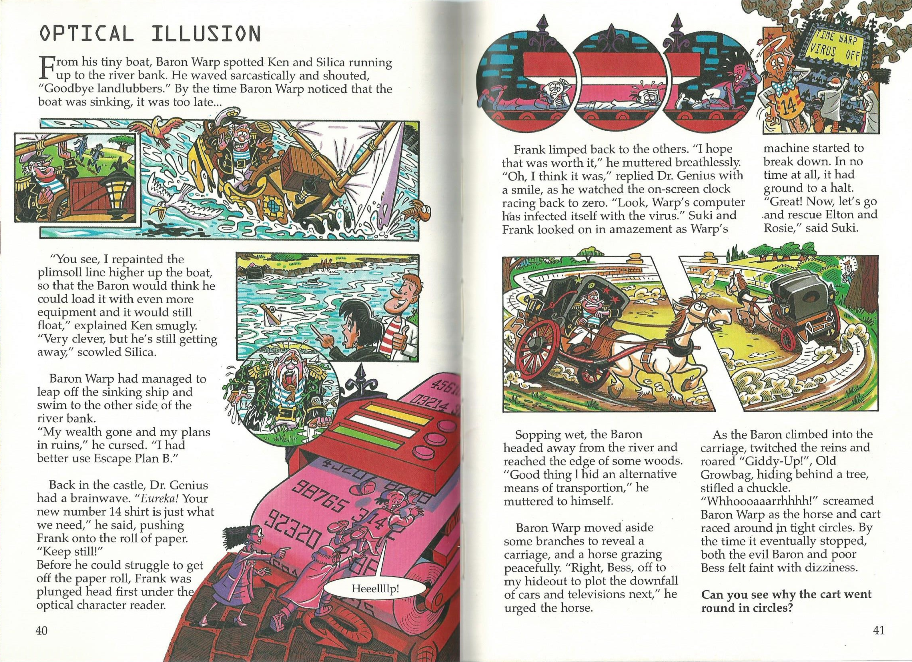
Yes, dear reader, that is what the basketball shirt was for. I am pleased to see that the physical abuse and humiliation of Frank Quark is a crucial part of this book’s narrative.
I do struggle to tell how the Baron could know, exactly, that all of his plans are in ruins at this stage, especially since at the time he says that his plans are in ruins then they haven’t actually been ruined yet. I guess he jumped the gun a little. The guy has a fish down his shirt at this point, I think he can tell which way the wind is blowing.
Kind of a shame he’s been defeated by improper carriage repair by the creepy gardener, though (shouldn’t that have been the handyman’s job?). I would have liked to see his plot to bring about the end of cars and television, too. But as with Max Chaos, it was not to be. The stars shone too bright, flared too fast.
Incidentally this comparatively trivial final puzzle doesn’t seem like it would work in real life? The carriage is being pulled by a horse, it’d just struggle to correct the weird steering but it wouldn’t be steered off in circles itself.
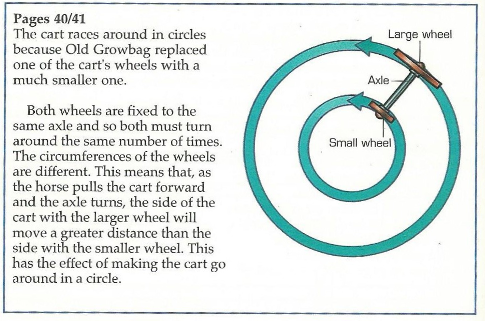
In short, this answer is completely implausible, and as such, completely suited to the rest of the book.
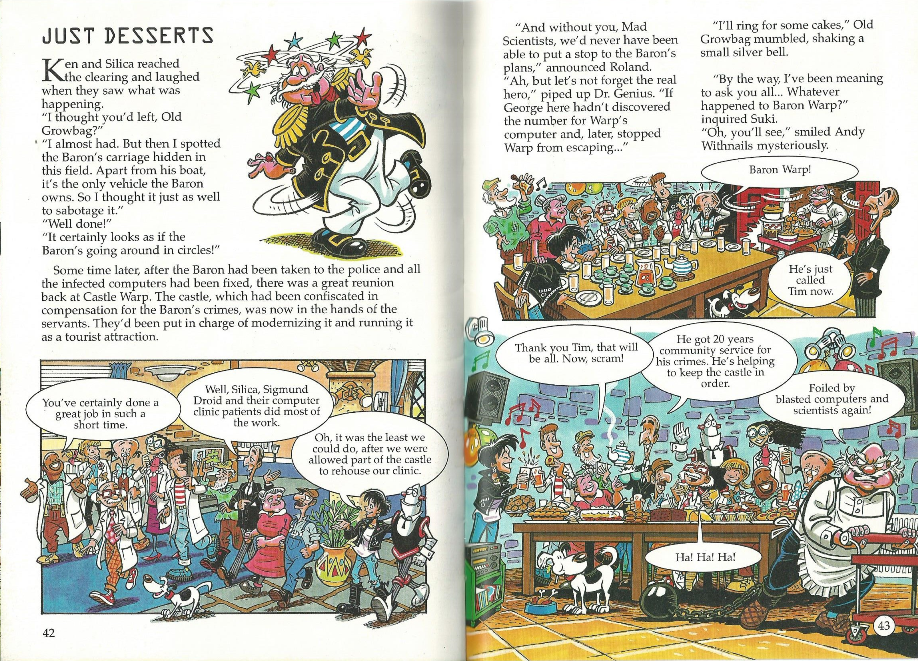
Proving, perhaps, that despite some glaring flaws it was far better-plotted than its predecessor, the book ends with a textbook denouement of everyone (even Rosie’s pet mouse) coming together for tea and cakes. It’s all very genteel and English, right down to the slap-on-the-wrist punishment given to the repeat criminal and cyberterrorist who just happens to be a member of the aristocracy. But order is restored and the class system vindicated as the brutish and scurrilous Warp is banished to his proper place, below stairs, while the noble and attractive former servants live high off the hog at his expense. A happy ending. If you ignore that Warp is suffering some medieval-level abuse by having a ball and chain fixed around his ankle while he’s also expected to serve everyone’s afternoon tea, and that the computer addicts were also forced into manual labour for no crime other than being a decade or two early to be spending all their time on their computers. Eh, Silica Stevens is smart, though, she probably just got her soulless mechanical boyfriend to do her share of the work. And Sigmund Droid probably chipped in too.
Also, they may boast about how nice a job they’ve done on the castle, but please take note that… there aren’t enough teacups on the table for everyone! Yes, that is how petty I am willing to be to score points against this book. I can safely say that this book has now been pretty thoroughly owned by me. Well, it is my property. The end!
…This was the final book in the Usborne Science Puzzle Adventures series, and, by extension, the Doctor Genius and the Mad Scientists series, and given that it was only the second instalment and the plot already wasn’t about science and a noticeable number of puzzles were actually maths puzzles, perhaps the series ending was for the best. Because the puzzles often relied on quite specific outside education rather than the application of general principles, it was often hard to even characterise them as “puzzles” at all, rather than tests of knowledge - an exam, almost, if a creative one. This makes the book somewhat unsatisfying to read, as there isn’t really anything to work out in such puzzles, simply to remember, and while it’s a fair cop that there were puzzles like that in the original Usborne Puzzle Adventures as well, it’s not a great approach to the title element of the series. This is added to the fact that at times the author seems to forget that he’s meant to be writing a science series at all, and includes things like mathematics puzzles where a science puzzle would be equally appropriate (for instance, in the test applied to the servants when they show up at the Mad Scientists’ laboratory); one may speculate that the series was originally intended to simply be an extension of the regular Usborne Puzzle Adventures, without quite such science-based advertisement, but then you still have a main cast made up entirely of scientists, several of whom completely forget their discipline throughout the story. The writing of both books is extremely patchy in this regard, and desperately needed another edit. As for the illustrations, I’ve revised my opinion of Geo Parkin after reading both books; he’s a fitting illustrator, but he really needs the right material, and characters standing around talking in offices is not really the right material. Again, though, that’s partly on the writing.
We’ll probably never know why there were only two of these books; did their flaws make them not sell, or were they just not a big hit with the commissioning publishers? Were they simply in the wrong place at the wrong time, failing to sell in a market weighed down with the classic and, frankly, better puzzle books? Or did this kind of book simply fall out of fashion - for when do you see any books like this anymore? It is difficult to say. But it is interesting to think about how one might go about revising the series to be a bit better. For my part, I would drop the overt “science” aspect and make the series more multidisciplinarily didactic. Instead of having a team of six scientists, we could have a team of multiple specialisms; keep Dr. Genius on science, then throw in a mathematician, a computer technician, a geographer maybe, a… literary critic? You’d also want an illustrator whose strengths play better to the story, or vice-versa; there were absolutely Usborne puzzle books of this calibre with more of an urban setting which were much more successfully illustrated than this, and at the same time there were books which made more of a commitment to getting the protagonists to an interesting setting fast. Perhaps what this really highlights is that Usborne Science Puzzle Adventures simply suffered from teething troubles; none of the creative team of Clive Gifford, Geo Parkin and Jane Chisholm (and Russell Punter, though it’s hard for an outsider to be sure exactly what “design” involved) seem to have been particularly experienced at working on this kind of book, and maybe with more time they’d have settled in. But we’ll never know, so that’s that.
In conclusion,
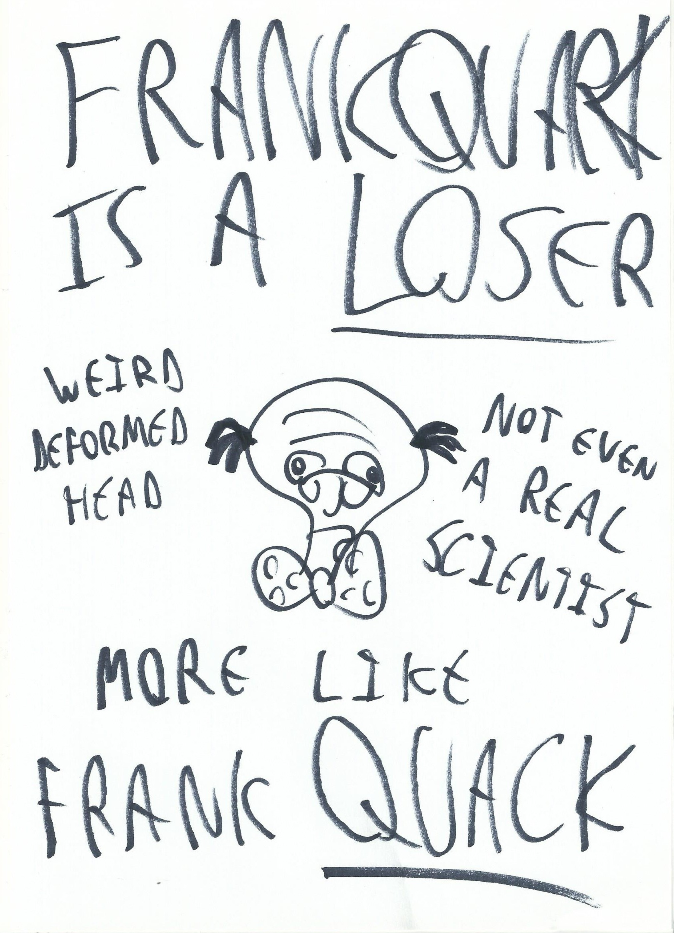
Usborne Science Puzzle Adventures #2 and Doctor Genius and the Mad Scientists #2 are both also #Final in each of those sub-series, and perhaps we begin to understand why when we read the title “The Time Warp Virus.” It’s a surprisingly apt title for an Internet review of a twenty-year-old book; less so much for a book which is meant to involve puzzles based on real science, neither time warps nor computer viruses being so. In a sense, I see their problem; the book is nonetheless too grounded in modernity to be an Usborne Puzzle Adventure, since they mostly preferred ghosts and mad science and other borderline-fantasy ideas. Regardless, I still think Clive Gifford et al. - all of whom return from their work on The Flask of Doom - simply lost their grip on what this series was meant to be about all too quickly. With the added flaw of the book dating really badly…

As the cover depicts, we have been blasted through a terrifying time warp back to the 90s when adults didn’t understand computers. Just slap this in the funnies page of the newspapers, minus the red-faced geriatric whose balloon-like head has inflated to occupy the entire monitor, and you’d be onto a winning satire on the difficulties your grandpa had with those new-fangled thingamajigs back in the day. For all his wits, Doctor Genius doesn’t even know how to use a mouse, holding it aloft and apparently attempting to manipulate the roller ball with his fingers, whilst clicking with his little finger stuck out like he’s the lady of the manor drinking a cup of tea. Suki Beaker and Rosie Bloom are doing their best to look active and engaged with the scene, despite the perspective revealing that they’re actually standing quite a few metres away, Suki retreating from a minor electrical storm whilst Rosie’s horrifying skeleton hand reaches out to grab a CD that’s being fired in the opposite direction. Elton Bolt gazes upon the whole scene with an air of naked disappointment. Frank Quark is just a mess. The cat is hardly even in the book.
Yeah, I should probably mention that this cover is actually a very poor representative of the actual plot of the book. Surprised?

Oh look, Suki Beaker is arbitrarily missing from a group shot on the cover again. What a surprise.
Anyway, the back cover also does a pretty poor job of telling us what the book is actually about. Can you tell from this synopsis what the eponymous Time Warp Virus actually does? Nope, which is a shame, as like the Flask of Doom from the last book it’s actually not a bad idea, just overhyped by the outlandish title. At least we have a suitably colourful villain in the conveniently-named Baron Timothy Warp, who despite being either a former or attempted supercriminal (it’s not clear which) and naming his computer-annihilating virus after himself has yet to be apprehended by the authorities, even though he lives in an actual castle, so once again it’s going to be up to the Mad Scientists to bring him in rather than calling the police to report a crime. On the plus side, spooky castles are a classic Usborne Puzzle Adventures setting so it’s hard to see how we can go wrong there, even if they are mega-generic and, you know, not really suited to either the theme of science or computers.

In further evidence of this book’s time-warping credentials, we see here that it anticipated the cosplay phenomenon.

You know the drill by now, I presume. This tag yourself meme depicts the Mad Scientists, a seemingly-random group of people of whom only one has any visible qualifications, who are slightly better at defeating supercriminal plots than they are at actual science, not that that’s saying much. Also, that example of Rosie Bloom’s particular blind spot suddenly strikes me as fairly arbitrary and, like much else, only indirectly related to scientific investigation. Couldn’t she not know one end of a telescope from the other? Or a particle accelerator?
Those disks though… I’m just kind of inwardly groaning here. Where do you even start. I don’t know what the scan quality on these is going to be like, but Dr. Genius’s files basically confirm that he is just an armchair detective with no actual interest in science. Do we even know what his doctorate is in? Frank is a total try-hard as usual even while only signing his name as “Mr. Quark,” so there we have it, just in case you thought any of these others had doctorates but just weren’t saying as much. What has this man been doing with his life, I mean just look at him. He’s in his forties, at best, and yet he’s calling himself a scientist despite not even having a doctorate and depending on literal children to read this book and solve puzzles for him. Elton obviously isn’t even a scientist; carpentry, for crying out loud. Rosie is so depressed at being dropped from the denouement of The Flask of Doom that she’s started writing poems for her pet mouse because she knows he’s the only one who’ll listen. The author couldn’t come up with anything chemistry-related for Suki’s interests that wasn’t painfully domestic, and yet it’s password-protected? Is she planning on publishing her recipes, is she actually trying to get a real job that isn’t being a fake scientist? Ken Plank is just a loser who downloaded some obvious malware disguised as virus protection from the Internet to protect him while he’s pirating knock-off video game hacks.
I don’t have any particular prejudice towards this book, and yet reading this page I just feel such contempt for these people. Irrational? Or all too rational? Either way, it’s a good start!

Okay, while at first glance this just looks like a rehash of the front cover’s ol’ “hackers can turn your home computer into a BOMB” theme, it turns out it’s actually another example of the Mad Scientists’ idiocy: Not only do they have lousy computer security, but they have linked absolutely everything in their laboratory to the computer, including the doors. Not the discs being ejected from the computer at rocket speed, though, that’s just magical computer virus witchcraft. What does the computer virus actually do? Whatever random thing would make this page look really funny, which is fair play, I guess. Maybe that’s Silica Stevens’s specialty, cartoon viruses that can do just about anything, though how Ken knows this virus is her work I don’t know. What I do know is that Ken knows far more about computers than he does about science. Maybe he should just go join the Mad Computer Technicians instead. Get himself a proper role.
Also, since I said the cat was hardly in the book, just look at this page and tell me where the text mentions it. It gets a nod on the next page, but this is the one and only time it’s illustrated. Clive Gifford and Geo Parkin just wanted to see a cat get electrocuted; ironic, given that “Mad Scientists Against Animal Experiments” poster… Rosie Bloom ought to look into this horrific animal abuse, maybe that could be the Mad Scientists’ next case. Though really, this is all just Frank’s fault - as is the puzzle on this page, which is only barely connected to the actual plot: Basically he nicked off with Ken’s computer security book for an experiment, except he then admits that he wasn’t using the book at all. That man is just the worst. No wonder Suki is so entertained when he’s smacked to the floor. That’s his fault too, by the way, as he’s the one who hooked up the computer to the doors, so he has nobody but himself to blame.
Anyway, how about that puzzle. Well, there are three elements in Frank’s experiment: A balloon, a piece of amber, and a van de Graaff generator, and two of them are charged with static. You have to identify all three of them - and no cheating, as not just they but several other props have been stacked on top of books, goodness knows why - and then identify which two are charged with static electricity. It’s actually a well-designed puzzle, to its credit, as you don’t need to know anything about van de Graaff generators or static electricity to solve it. Just locate the balloon and the amber, and from there, infer what static electricity does and what the van de Graaf generator might have in common with them.

Dr. Genius doesn’t actually really explain what static electricity is here, just what it does. But hey, at least it’s a science puzzle.

A fundamental difference between this and earlier Usborne Puzzle Adventures is that USPA has a tendency to just flat-out tell you the answer to the puzzle on the next page. It even goes most of the way to explaining it. Tell me why we need an answer section, again? Anyway, everyone tells Frank to shut up, so this is a good page.
Well, no, not really, it’s not a good page. The book has this… really weird habit of continually referring to elements and effects of the virus as if we’re familiar with them, when we never have. For instance, right here, Suki talks about the computer’s clock travelling back to 7am as if this was a thing we already knew was happening, but it’s not established at all; the previous page mentioned a computer-controlled clock, but this appears to be different. Nor does anyone actually connect the fact that the virus is called the Time Warp Virus to the clocks going backwards, we’re left to assume for ourselves that this is the virus’s main feature. And then Ken discovers that 67 is the code - great! The code to what? Nobody’s introduced any need for a code or what it would do or how it relates to the virus. It’s like there’s a paragraph missing somewhere that ties all these things up, but it’s just dropped in favour of more breakfast invention slapstick that Wallace & Gromit had been doing better for years.
Also, the Time Warp Virus wasn’t invented by Baron Timothy Warp, so it being basically named after him is a complete coincidence. Which isn’t necessarily a problem, but stacked up with everything else I’m already starting to get the feeling that, like the previous title, the plot of this book needed a second pass. Or an actual editor. Looking up series editor Jane Chisholm, it seems like pretty much everything she worked on was non-fiction. …And quite a lot of it computer-related. Coincidence?
Oh, and last but by no means least… this is a maths puzzle, like, flat-out. Just call it Usborne Educational Puzzle Adventures and be done with it!

A maths puzzle, maybe a computer puzzle, but certainly not a science puzzle. This whole sub-series needed a second pass.

More than half the pictures on this double-page are just of people looking at a computer screen. Exciting stuff. Now, please learn about some of the most basic elements of computer operation while we remove this virus the only way fiction writers of the 90s knew how, by solving a puzzle the virus writer inserted to let you defeat their efforts with no consequences by solving some general knowledge test or a whimsical logic puzzle. Watch out, ransomware scum, I’ve read a book.
Meanwhile Dr. Genius conveniently learnt everything about the Time Warp Virus off-screen on the Internet, completely invalidating everything Ken’s done in the plot so far. And Suki appears in the group shot which the one on the back cover is based on, in which she does not appear. Somebody at Usborne really didn’t like her. I don’t think it was Clive Gifford, though, as on this page she appears to know just as much about photosynthesis as the biologist member of the team, who is robbed by mysterious apples of her chance to shine. Get it, shine? It’s a pun on the answer to the puzzle? Which they pretty much give to you, and it’s the easiest one anyway?

No complaints about the answer, just about the puzzle’s presentation. I don’t get why some of the panels had different background colours, or why there was no indication of which icons had already been clicked. Don’t think of it as “poor design,” think of them as red herrings!

Ken is the butt of the book’s jokes this page, getting everyone soaked by the sprinklers and then being reduced to this horrifying computer zombie with an actual five o’ clock shadow, in an amazing enlargement by Geo Parkin upon the text’s simple “sleepy”. Ken also appears to be a leet hacker as he has a long list of all the computers in the world that have been affected by the virus… for some reason. Why does he need this, again? Also, everything is Elton’s fault rather than Frank’s, for a change. A floppy disk through the mail, really, Elton (I actually typed “Frank” there out of habit). But who could resist that cryptic yet nattily-designed message! Yeah, no wonder Dr. Genius no longer trusts Elton to even make a telephone call unsupervised.
Well, it took a quarter of the book, but the villain finally appeared, and he’s the best character in the book already. Overlook the fact that his master plan was to send his own telephone number with the virus, and that he keeps a big scrapbook of his personal failures (all the newspapers interview major criminals on petty gossip), and look how much more Geo Parkin was enjoying this second page than the rest of the story. Flaming torch, gramophone, a pewter flagon of mead! This is great! There’s even a classic trace-the-paths puzzle, for which I’ll forgive the fact that it’s once again computer-themed rather than being related to science. I’m not even questioning why we’re supposed to help the Baron here, he’s the reason we’re reading this, let’s be honest.

Ordinarily, in this sort of puzzle, you’d expect the other two cables to be joined to each other. Well, it’s a minor point.

At the Computer Addicts’ Clinic, Dr. Genius is humiliated by a robot. Deservedly. I don’t even know what reference he was trying to make there, everyone knows “Take us to your leader” is the thing the aliens say to the humans. If a human says it to a robot, that’s not even a reference at all, it’s just an embarrassment. Also, this robot apparently has human-level intelligence, so nice job putting a factual error in your educational book. Or is it okay if it’s a computer science error rather than an actual science error?
Clive Gifford racks up what he clearly thinks is some pretty biting satire on those crazy kids who spend all their time on their computer by slowly weaning them on a radical alternative therapy called “actual reality.” Just jump twenty years into the future and say that, why don’t you. I bet he wrote the book on a computer, too. Hilariously, Gifford and Parkin’s idea of “actual reality” involves reading a copy of The Flask of Doom. But you all read that on a computer in the last instalment, didn’t you? You’re part of the problem!
But at last, we are introduced to Silica Stevens, who turns out to be a cool hacker girl wearing a leather jacket. This book couldn’t be more 90s if it tried. Just watch her know more about science than the actual Mad Scientists, though. Hell, put her on the team! She can replace Frank, he’s not doing anything. Like literally, he doesn’t even bother solving the problem, he just runs off so he doesn’t have to prove anything. Get out!
…Despite the last few pages all cramming in subtle details in the images which are blatantly hinting towards later puzzles, I’m not sure how you’re meant to solve this one unless you already know it. Unfortunately I saw the answer while leafing through the book to check something a while back, so I’ve no idea how easy or hard this would have been if I’d actually had to think about it. You want to alter its density, I guess…?

Well, yeah, you do want to alter its density, but one of the most verbose answers in the book, for a puzzle which strictly speaking has no direct importance to the plot, doesn’t actually mention density anymore. It kind of switches to a different principle, that of displacement, even if changing the volume of the clay object does, in fact, reduce its density. The more you know! Apparently this is a classic science experiment, but funnily enough, I don’t remember ever encountering it myself. Then again, I’ve read this book, so I suppose I have no excuses.

What is it with Ken and actually knowing things and being worthwhile in this book. The foundations of my world are trembling here. Though I have to say, I like how somebody finally asked for proof that the main characters are actually scientists. After all, anyone can put on a lab coat, right?
Uh-oh, though, looks like somebody has a bit of a soft spot for Ken! Whose reactions I kind of can’t figure out; he was looking pretty bashful himself the previous page, but the moment Silica herself expresses an interest, he backpedals like crazy. And then everyone laughs at him. Poor Ken, he has to go and spend some quality time with the cool hacker girl who has a massive crush on him and isn’t afraid to say it, who’d want to be in his shoes? Don’t worry, Ken, you’re doing it for the planet! Remember the Mad Scientists’ motto which they never mentioned before and blatantly made up just now!
Meanwhile Frank ruins some kid’s rehabilitation and gets given a basketball shirt. This awful man just taints everything he touches and Dr. Genius rightly loses his cool with him… while Suki laughs some more. Well, at least one person’s enjoying themselves. Abruptly a puzzle.
The puzzle is… well, I am aware that you at home cannot actually read it, but trust me, you are not missing anything. It’s mirror text with frills. Like they could at least have typed it backwards rather than literally mirroring the whole thing, that just makes it obvious. There’s this whole vowel-swap thing that it feels like they threw in there after the fact as they realised the puzzle was too easy, but no, it was still too easy.

Are you serious? You’re talking to an Usborne Puzzle Adventures veteran here, you think I don’t know how mirror text works? Back in my day you had to use a mirror just to read the hints, blah-blah-blah, yackity schmackity. Meanwhile, top government computer security experts put out calls for help to random people on the Internet. Are we… like given that you just told us that Baron Warp had previously gone by the codeword “Revenge,” are you seriously telling me this man who supposedly knows absolutely nothing about computers managed to hack into a top government database? Heavens above, is there anyone useful in this tragic world.

…Well, Rosie and Elton sure aren’t being useful. They’ve completely abandoned actually investigating the Time Warp Virus and are just chortling over a file about bumbling criminal morons of the sort even they can defeat. They come across vital information about Baron Warp entirely by coincidence. And, in much the same way as they couldn’t be bothered to do any work, Clive Gifford also couldn’t be bothered to think of any ways in which Baron Warp was actually foiled by computers.
Speaking of not doing any work, suddenly a bunch of ex-servants show up and start babbling a bunch of clues and foreshadowing. So the Baron mixed up his measurements and had an enormous computer built? I guess he’s behind the times with the metric system as well as computers. To my complete astonishment, we learn that somebody actually went to the police… and what do you know, the police were useless. If they can’t do anything with their computers, doesn’t that kind of free them up to do some actual police work - oh yeah, that would entail somebody in this story actually doing something useful for a change.
So, hold on. Like this guy is some kind of ex-criminal - who the servants nonetheless freely chose to work for before this whole computer business came up, by the way - and what scared them off was when he built a giant computer. Are these yokels even more technophobic than him?
Anyway, and now we get another puzzle that… well, yeah, it’s maths-based again. Not even halfway through the book, and that’s two of them already. And less than half the puzzles we’ve encountered so far were science puzzles. Are we sure Clive Gifford knew he was meant to be writing Usborne Science Puzzle Adventures here?
So. All the angles in a triangle add up to a hundred and eighty degrees; all the angles in a square, three hundred and sixty. So all the angles in a pentagram…?

Told you they’d started dropping hints like crazy. And some of them are even science-based, too…

For some reason I didn’t pick up at first on the fact that the servants don’t actually have to solve the puzzle, they literally just got given the answer by someone else. Why did it even have to be a puzzle, then? Why not a codeword, or just a piece of paper ripped in half? Er, anyway, apparently the servants know for a fact that Baron Timothy Warp is behind the Time Warp Virus and literally told them that he was doing this for revenge, but the police still can’t be bothered to send somebody to deal with the source of the Time Warp Virus because they’re too busy dealing with the Time Warp Virus… and getting the witnesses to fill in paperwork. I kind of think this world deserves everything it gets.
On the plus side, we’re getting closer to the interesting bit, which is that this book has a castle. Apparently this world has no atlases, though, so the servants had to sketch up some maps of their own to direct Rosie and Elton to a notable landmark. You know what, I’ll take it. Given how incompetent the police are, Baron Warp could’ve taken down all the signposts and nobody would be able to stop him.
Time is of the essence, so Rosie and Elton don’t bother to contact the other two-thirds of their team… but Rosie does insist on taking their bikes out. We’re in a hurry, Elton! The world is depending on us! Pedal faster! Wait what the heck is that bird to the left of Elton. For crying out loud we had some perfectly decent cliff-nesting seabirds in the previous book, but no, now all we’re getting are Pokémon rejects. Now, flip back another couple of pages and tell me what direction 315° is. You did remember to bring a compass, right?

You know, if they were asking me to remember some entirely fictitious fact or spot some narratively-relevant detail, I’d be fine with it, but here it just feels like they’re giving the answers away. On completely different pages.

Suddenly a creepy old man jumps out of the bushes and tells Rosie to put on a maid’s outfit. Woah, I didn’t think this was that kind of story. It turns out the gardener (probably) sent that basket of apples earlier, but anticipated that the Mad Scientists would ignore his clues, so he sent along an extra note, which they have also ignored. Why is he relying on these people, again? I mean, just look at this: Elton complains, “The previous butler must have been tiny!” Elton you met the previous butler. You last saw him one page ago. (Admittedly, he was called a “head waiter,” but we haven’t seen any other butlers and his costume was identical.)
Meanwhile again, Frank has indeed been bullied by Dr. Genius into wearing the basketball shirt and cap, and is complaining as usual. Far be it from me to agree with this waste of oxygen, but in this case, when time is of the essence, the whole world is upon the brink of chaos, did Rosie really have to take the time to indicate her intentions in a coded note? …That’s not even in her subject area?
Wait, hold up a bit. Frank’s a physicist. Space is meant to be up his alley. The note is pinned to his solar system chart. …Frank’s floppy disk on the opening page contains “Notes for my brilliant lectures on Space.” And yet he’s lost when presented with a space-related puzzle! This man is a damn fraud! I just… I just hate Frank Quark so much.

The words are anagrams and the whole sentence is out of order, and pinned to the planets for no reason? Listen, Rosie, you don’t have anything to prove. Not while you’re on a team with Frank Quark.

As Rosie and Elton walk through the most Usborne Puzzle Adventures castle ever, Rosie responds to a request for a pen by pulling a lemon out of her pocket. Am I living through some kind of surreal dream? Meanwhile, it’s confirmed that my quip earlier about Baron Warp mixing up imperial and metric measurements was, in fact, canon. Also, why did Rosie and Elton have to put on disguises if the Baron immediately recognised them as intruders despite their disguises? I knew that old gardener was just a creeper!
Eventually, the pair come across a puzzle which arbitrarily requires our help to solve. And… yep, it’s a maths puzzle again. But just ignore the fact that it’s unbelievably easy when they give you the fact that one turn of the small gear makes a half turn of the larger gear, and ask yourself this: Why do Rosie and Elton need to work this out in advance? Why can’t they just turn the small gear until the diagram on the large gear is oriented vertically again? Or, I don’t know, watch the door opening as they turn it? In real life, this wouldn’t even be a puzzle!

The puzzle is literally that one plus one equals two. Apparently the Mad Scientists are even worse at maths than they are at science.

Isn’t Elton meant to be an engineer? Shouldn’t this type of unbelievably basic mechanism be pretty much his jam? I give up on trying to understand these people. Meanwhile, Baron Warp unlocks the door by turning the small gear twice, but since Elton had already turned it half a turn, this means that the large gear actually made a total of one and a quarter turns, so either the puzzle lied or you really were allowed to just turn the gear until the door opened and you could just ignore the puzzle entirely. Good job!
The fact that his new servants have drawn a map of their large and confusing new workplace proves to Baron Warp that they are actually despicable traitors, and to further his ultimate end of being taken seriously, he decides to add murder to his list of crimes and chases Rosie and Elton around with a sword. Upon being trapped and seeing a further half of the Mad Scientists arrive through a hole in the wall, Rosie comes up with an engineering solution. I know Elton refines the paper aeroplane, but did he just forget these past few pages what his specialism is meant to be? Also I feel like the two of them could just have called for help. Look, Rosie can easily fit her head and arm through that window, you’re really telling me that a scarily precise bit of paper aeroplane engineering will be better at catching Dr. Genius’s attention?
It also strikes me that this puzzle would have been more effective if the paper plane were oriented the other way in the diagram. We want it to turn left, but when facing the front of it that actually means we want it to turn right.

See, “left” from the perspective of this diagram is actually “right” in the orientation as shown in the puzzle. …Also I feel it’s disappointingly straightforward that to make the plane turn left you have to turn the rudder left, but I guess you can’t argue with physics.

I’m revising my opinion on illustrator Geo Parkin. Give him the right material and he really comes up with the goods. This scene is gorgeous.
The text, on the other hand, is business as usual. Frank once again annoys even the other characters and then manages to be useless at his own specialism - whilst also confirming that Elton is meant to be the expert on gears, so he should’ve been on top of his game against that simplistic door lock from earlier. Based on Elton’s performance there, I wouldn’t want him to help out with this puzzle or he’d throw half the cast down to the crocodiles. But on the plus side, we’d get rid of Frank. Hmm, on the whole, it’s probably worth it.
It’s a shame that there’s a very clear visual indication of how the cog puzzle will sever the rope and plunge them into the crocodile-infested moat, but none of how exactly it’s meant to open the door. Also, once again, as in real life, just turning the handle slightly in either direction would show you which direction it moves the crocodile in without moving it enough to endanger the drawbridge, but this puzzle is more interesting so I’ll give it a free pass. Standard rules apply, though; all that really matters is whether you have an odd or an even number of gears, as each extra pair of gears cancels out.

Complicated only slightly by the psychological factor that the crocodile both does and doesn’t work like a gear. It’s actually quite an interesting design.

As Frank’s cap grows ever larger with each fresh page, we cut back to Ken and Silica Stevens - remember them? Silica Stevens, being a cool 90s hacker girl with a leather jacket, also owns a motorcycle with flame patterns painted on it, but as the character with the best design in the entire book - save maybe Baron Warp, who has about half a dozen different designs - she gets a free pass on clichés.
At last, we find out what that business with the apples was about. It was so Old Growbag, the creepy gardener, could record the phone number of Baron Warp’s computer - wow, that takes me back, to the days when the Internet explicitly dialled through your phone line and so you couldn’t surf the web and make a telephone call at the same time, and you couldn’t be connected for more than about fifteen minutes per day without running up a huge phone bill. This must seem insane to anyone born since the millennium. Anyway, rather than just memorising the phone number, Growbag split the numbers and pasted them onto apples and then sent them to some scientists, along with a note explaining how to deduce the phone number from the apples, even though he could just have written the phone number down and sent it in the note. Or told Rosie and Elton the phone number when they arrived at the castle, since he had to have remembered it in order to provide the correct clues.
Also old Growbag seems extremely confused about both the chronology of the story and the number of notes he sent. He claims he sent the apples several days ago, but they only arrived less than twenty-four hours ago in the story’s chronology. Also, we’ve seen no sign of the coded note supposedly left on the basket, only the note Ken and Silica are reading right now, which implicitly is the one which came with the basket of apples, except it appears to have been written several days after the apples were sent… The convoluted set-up of the apple puzzle makes slightly more sense if you assume that Growbag is getting a little bit confused in his old age.
…Also, this is another maths puzzle, isn’t it. Mitigated slightly by that seemingly extraneous but totally fabulous panel of the villain waxing his moustache. Clive Gifford can’t do puzzles, but he sure can do villains.

I was going to say that it was awfully convenient that there were no duplicate numbers in the Baron’s phone number, but then I realised it wouldn’t actually have made the puzzle any more difficult if it did.

Silica narrowly avoids crushing some more interestingly-designed wildlife - the bird designs have been on-point again since that cartoon blue bird way back when Rosie and Elton set out - and quite by chance she and Ken stumble upon an apparently irrelevant tangent. I kind of wish this had been an unspoken plan and we’d only get the plimsoll line punchline later, but it’s very rare for Ken to do something actually intelligent so I guess we’ll give him his moment in the sun a bit early. Also wow, look at that boat’s figurehead, it’s something else. Still doesn’t top the figurehead of a certain ship in A Series of Unfortunate Events which is shaped like a person in a diving suit being attacked by an octopus.
Meanwhile, the rest of the gang try to find the computer room. They’ve gotta go fast!

Probably the reason they had Dr. Genius rub it in by repeatedly calling Frank a lemon - not that you really need a reason - is because Rosie had no reason to write her map in invisible ink in the first place. How would she even keep track of what lines she had drawn already?

Frank and Suki stare gormlessly at their brilliant leader as he explains the lemon juice trick. It’s all to do with chemical reactions! Wait, isn’t Suki a chemist? Oh for crying out loud.
Also Frank once again starts lecturing loudly and the narrative doesn’t even bother to tell us what Dr. Genius said to him, it’s enough that he just shut him up. I like to think that Dr. Genius didn’t say anything to Frank, just gave him a swift smack ‘round the chops.
On the other hand, we do have a real science puzzle here at last! And it’s a good one, too. I always like these kinds of puzzles. I’ve no idea why they bothered with the slightly misleading blather about two light sensors when you’re given one for free at the start, but the puzzle even has the good kind of hint where you’re told just how many movements you need to make! Though you need that kind of hint. If you had free movement of the mirrors, you could brute-force any number of possible combinations. Actually, puzzles like this are really just another kind of maze, and as with many such mazes, the easiest way of solving it is actually to work from the end backwards.

The periscope was kind of an abstract hint to relate to this, considering that periscopes are vertical and this is horizontal, even if the principle is the same when drawn on paper. Also, you point out this hint and not the pi and invisible ink hints?

Well, that’s everything all wrapped up for the Baron! Looks like, as in The Flask of Doom, there’s to be no final confrontation between the Mad Scientists and the villain, just an attempt to derail an automated plan he set off well in advance. Well, they are scientists. They don’t really do final battles. In both books the heroes did actually confront the villains at one point and lost and were captured, so stealth is clearly the better approach.
So, Dr. Genius, Suki and Frank open the door, only to immediately find… another door. Creative. They’ll need an amber light to get through that door, and if Rosie and Elton had left proper notes back at the lab then Dr. Genius could’ve brought the actual physical chunk of amber Frank was using in his experiment, but no, they need to jerry-rig something out of the wrappers to all these chocolates Suki is hauling about. I won’t judge. …I won’t judge Suki, but hark at Frank once again blathering away, to camera, while Suki and Dr. Genius do all the work. Has Frank actually done anything useful in this book? At all?
Wouldn’t you know it, there aren’t even any yellow-wrapped chocolates in this whole heap. Fortunately, there’s another way to make yellow. That’s right, Frank’s basketball shirt! …Would’ve been a clever out-of-the-box solution, but nope, it’s the chocolates.

Now this I think you did need a hint for. So of course there isn’t one. The puzzles in Usborne Science Puzzle Adventures are a fairly awkward balance of inside observation and required outside knowledge. Don’t know about primary light colours? Too bad, the world is doomed, and all because Frank Quark can’t do his job.

And to give the old technophobe credit, when he builds a computer, he builds a heck of a computer. Baron Warp doesn’t do anything by half-measures. Though of course, measures are precisely his problem. Are we sure that, rather than confusing imperial and metric, he didn’t mix up his decimal points and use commas instead of periods?
But oh no, the computer is protected by a row of laser beams that are clearly several feet off the floor and which we could easily crawl under! Also laser beams are just light, they don’t actually harm you, so you can walk right through them since there’s no security system they could set off that wouldn’t stop you from simply pulling the power cord out of the computer. But details. This is secondary to Dr. Genius getting so greedy for chocolates that he actually loses his fillings. Those toffees are pretty vicious, it must be said. Take caution in cold conditions.
Oh yeah, I guess I should mention that Frank Quark’s time to shine finally came. Sigh. You know he’ll never stop bragging about this. Even if what he had to do to succeed was kind of disgusting.

Of course, the fact is that the castle’s full of metal things and the characters are probably toting around a lot of metal stuff as well that they simply didn’t think of. But when the filling’s right there and it’s the right size and shape, you just have to grit your teeth (eh?), bite the bullet (eh eh?), and generally grin and bear it (eh eh eh… well, that’s not quite so directly tooth-related, I guess).

Frank slowly regurgitates the answers page after having already solved the puzzle, leaving the Baron plenty of time to merrily sail away. Apparently the computer is also built to exceptionally sturdy specifications, as the frail and weedy Mad Scientists are unable to affect it even slightly, or possess the imagination to look for a power cable. Or maybe it’s battery-powered? I’m not terribly certain that Warp Castle even has an electricity supply…
Fortunately for all, Dr. Genius pulls out a mobile phone - or walkie-talkie, it’s the 1990s so same difference - which has never before been seen or mentioned because we’ve run out of pages with which to explain how Ken and Silica could otherwise transmit the final piece of the puzzle to Team Spectacles, through which Ken and Silica transmit the final piece of the puzzle to Team Spectacles. But how can they falsify one of the phone numbers on the OCR? Looks like it’s time for a puzzle! But not this one, even though it’s much more interesting and clever. No, instead we’re tasked with figuring out what will happen to an overburdened ship with a falsified plimsoll line. I like how you can answer it just as well if you completely ignored the lecture on the plimsoll line earlier.

Has any person who ever read this book actually had the need to look at this particular answer? I’m almost surprised they even printed it.

Yes, dear reader, that is what the basketball shirt was for. I am pleased to see that the physical abuse and humiliation of Frank Quark is a crucial part of this book’s narrative.
I do struggle to tell how the Baron could know, exactly, that all of his plans are in ruins at this stage, especially since at the time he says that his plans are in ruins then they haven’t actually been ruined yet. I guess he jumped the gun a little. The guy has a fish down his shirt at this point, I think he can tell which way the wind is blowing.
Kind of a shame he’s been defeated by improper carriage repair by the creepy gardener, though (shouldn’t that have been the handyman’s job?). I would have liked to see his plot to bring about the end of cars and television, too. But as with Max Chaos, it was not to be. The stars shone too bright, flared too fast.
Incidentally this comparatively trivial final puzzle doesn’t seem like it would work in real life? The carriage is being pulled by a horse, it’d just struggle to correct the weird steering but it wouldn’t be steered off in circles itself.

In short, this answer is completely implausible, and as such, completely suited to the rest of the book.

Proving, perhaps, that despite some glaring flaws it was far better-plotted than its predecessor, the book ends with a textbook denouement of everyone (even Rosie’s pet mouse) coming together for tea and cakes. It’s all very genteel and English, right down to the slap-on-the-wrist punishment given to the repeat criminal and cyberterrorist who just happens to be a member of the aristocracy. But order is restored and the class system vindicated as the brutish and scurrilous Warp is banished to his proper place, below stairs, while the noble and attractive former servants live high off the hog at his expense. A happy ending. If you ignore that Warp is suffering some medieval-level abuse by having a ball and chain fixed around his ankle while he’s also expected to serve everyone’s afternoon tea, and that the computer addicts were also forced into manual labour for no crime other than being a decade or two early to be spending all their time on their computers. Eh, Silica Stevens is smart, though, she probably just got her soulless mechanical boyfriend to do her share of the work. And Sigmund Droid probably chipped in too.
Also, they may boast about how nice a job they’ve done on the castle, but please take note that… there aren’t enough teacups on the table for everyone! Yes, that is how petty I am willing to be to score points against this book. I can safely say that this book has now been pretty thoroughly owned by me. Well, it is my property. The end!
…This was the final book in the Usborne Science Puzzle Adventures series, and, by extension, the Doctor Genius and the Mad Scientists series, and given that it was only the second instalment and the plot already wasn’t about science and a noticeable number of puzzles were actually maths puzzles, perhaps the series ending was for the best. Because the puzzles often relied on quite specific outside education rather than the application of general principles, it was often hard to even characterise them as “puzzles” at all, rather than tests of knowledge - an exam, almost, if a creative one. This makes the book somewhat unsatisfying to read, as there isn’t really anything to work out in such puzzles, simply to remember, and while it’s a fair cop that there were puzzles like that in the original Usborne Puzzle Adventures as well, it’s not a great approach to the title element of the series. This is added to the fact that at times the author seems to forget that he’s meant to be writing a science series at all, and includes things like mathematics puzzles where a science puzzle would be equally appropriate (for instance, in the test applied to the servants when they show up at the Mad Scientists’ laboratory); one may speculate that the series was originally intended to simply be an extension of the regular Usborne Puzzle Adventures, without quite such science-based advertisement, but then you still have a main cast made up entirely of scientists, several of whom completely forget their discipline throughout the story. The writing of both books is extremely patchy in this regard, and desperately needed another edit. As for the illustrations, I’ve revised my opinion of Geo Parkin after reading both books; he’s a fitting illustrator, but he really needs the right material, and characters standing around talking in offices is not really the right material. Again, though, that’s partly on the writing.
We’ll probably never know why there were only two of these books; did their flaws make them not sell, or were they just not a big hit with the commissioning publishers? Were they simply in the wrong place at the wrong time, failing to sell in a market weighed down with the classic and, frankly, better puzzle books? Or did this kind of book simply fall out of fashion - for when do you see any books like this anymore? It is difficult to say. But it is interesting to think about how one might go about revising the series to be a bit better. For my part, I would drop the overt “science” aspect and make the series more multidisciplinarily didactic. Instead of having a team of six scientists, we could have a team of multiple specialisms; keep Dr. Genius on science, then throw in a mathematician, a computer technician, a geographer maybe, a… literary critic? You’d also want an illustrator whose strengths play better to the story, or vice-versa; there were absolutely Usborne puzzle books of this calibre with more of an urban setting which were much more successfully illustrated than this, and at the same time there were books which made more of a commitment to getting the protagonists to an interesting setting fast. Perhaps what this really highlights is that Usborne Science Puzzle Adventures simply suffered from teething troubles; none of the creative team of Clive Gifford, Geo Parkin and Jane Chisholm (and Russell Punter, though it’s hard for an outsider to be sure exactly what “design” involved) seem to have been particularly experienced at working on this kind of book, and maybe with more time they’d have settled in. But we’ll never know, so that’s that.
In conclusion,
